In July 2024, Micron announced the 9550 NVMe SSD family, a Gen5 platform built for the next wave of enterprise storage deployments. At that time, we covered the launch and highlighted the two product tiers: the PRO for read-intensive environments and the MAX for mixed-use workloads. Micron has since provided us with a sample of the 9550 MAX, allowing us to put the higher-endurance member of the family through our thorough enterprise lab testing.
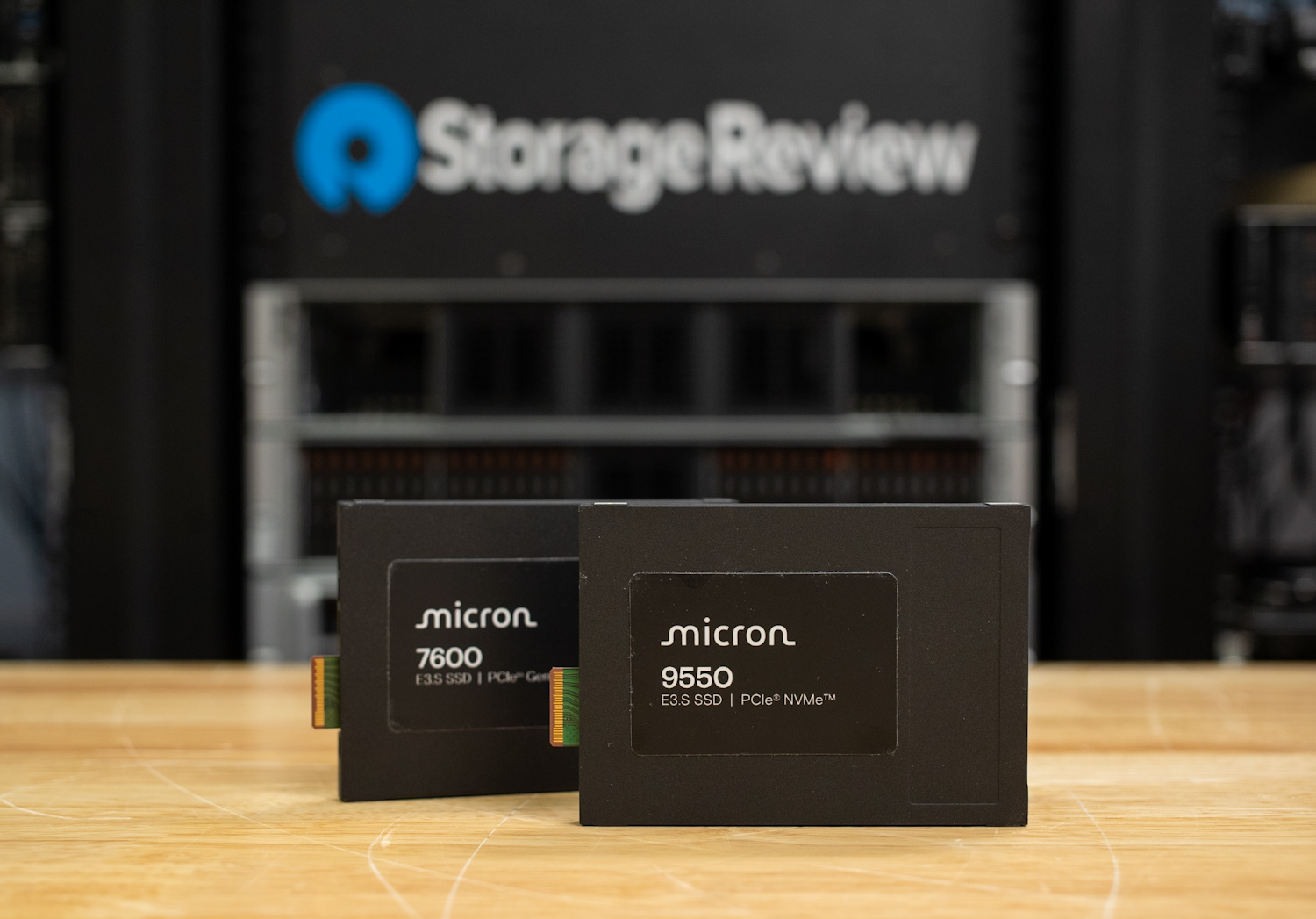
The 9550 MAX is purpose-built for mixed-use workloads where reads and writes are balanced, making endurance and sustained performance just as important as raw throughput. This makes it ideal for databases, analytics, AI/ML training pipelines, and financial applications that involve high, continuous transaction rates.
Capacities range from 3.2TB to 25.6TB, covering a wide range of deployment scenarios, from smaller application drives to high-capacity consolidation in dense storage nodes. The 9550 MAX is available in both U.2 and E3.S form factors, giving enterprises flexibility as they transition from established 2.5-inch infrastructure to next-generation EDSFF platforms.
Compared to the PRO line, which emphasizes read performance at lower endurance, the MAX delivers up to three drive writes per day (DWPD), making it the clear choice for environments with write-heavy or balanced workloads. The Pro and Max lines are coupled with PCIe Gen5 performance, NVMe 2.0, and (OCP) 2.0-2.5 compliance; the 9550 series SSDs stand out as a drive designed for speed and reliability at scale.
Positioned above the Micron 7600 series SSD’s, which serves mainstream data center workloads with exceptional latency and energy efficiency, the 9550 series delivers higher endurance, broader capacity options, and superior sustained performance for data-intensive environments that require maximum consistency and throughput under load
Micron 9550 MAX Specifications
The table below outlines the Micron 9550 MAX series SSDs, highlighting their form factors, performance metrics, endurance ratings, and capacity options across U.2 and E3.S models.
| Micron 9550 MAX Specifications (U.2 / E3.S) | |||||
|---|---|---|---|---|---|
| Use Case | Mixed-Use (3 Drive Writes per Day) | ||||
| Interface / Protocol | PCIe Gen5 x4, NVMe v2.0b | ||||
| NAND | Micron 232-layer 3D TLC NAND | ||||
| OCP Compliance | OCP 2.0 (r21) | ||||
| Reliability | MTTF: 2.0M hours @ 0–55°C; 2.5M hours @ 0–50°C | UBER < 1 sector per 1017 bits read | 5-year warranty | ||||
| Power (avg. RMS) | ≤ 18 W sequential read; ≤ 18 W sequential write | ||||
| Operating Temperature | 0–70 °C | ||||
| Capacities & Performance (9550 MAX) | |||||
| Capacity | Seq. Read (MB/s) | Seq. Write (MB/s) | Rand. Read (K IOPS) | Rand. Write (K IOPS) | 70/30 R/W (K IOPS) |
| 3.2TB | 14,000 | 10,000 | 3,000 | 540 | 640 |
| 6.4TB | 14,000 | 10,000 | 3,300 | 640 | 720 |
| 12.8TB | 14,000 | 10,000 | 3,300 | 820 | 1,000 |
| 25.6TB | 14,000 | 10,000 | 3,300 | 1,200 | 1,300 |
| Typical Latency (µs) | |||||
| Read | 60 | ||||
| Write | 15 | ||||
| Endurance (Total Bytes Written, TB) | |||||
| Capacity | RND TBW | SEQ TBW | Notes | ||
| 3.2TB | 17,520 | 37,200 | MAX (3 DWPD) | ||
| 6.4TB | 35,040 | 74,200 | MAX (3 DWPD) | ||
| 12.8TB | 70,080 | 143,100 | MAX (3 DWPD) | ||
| 25.6TB | 140,160 | 282,600 | MAX (3 DWPD) | ||
Micron 9550 MAX Design and Build
Micron positions the 9550 MAX as a mixed-use enterprise SSD designed for balanced read/write workloads at 3 DWPD. It pairs a PCIe Gen5 x4 interface with NVMe 2.0b protocol support and Micron’s 232-layer 3D TLC NAND technology to emphasize consistent latency under sustained load.
Physically, the drive family spans U.2 and E3.S form factors, giving operators flexibility to drop into today’s 2.5-inch NVMe bays or move into denser EDSFF deployments without changing platforms. This versatility is reinforced by compliance with OCP 2.0 and 2.5, aligning the 9550 MAX with the mechanical, thermal, and management expectations common in modern hyperscale and enterprise servers.
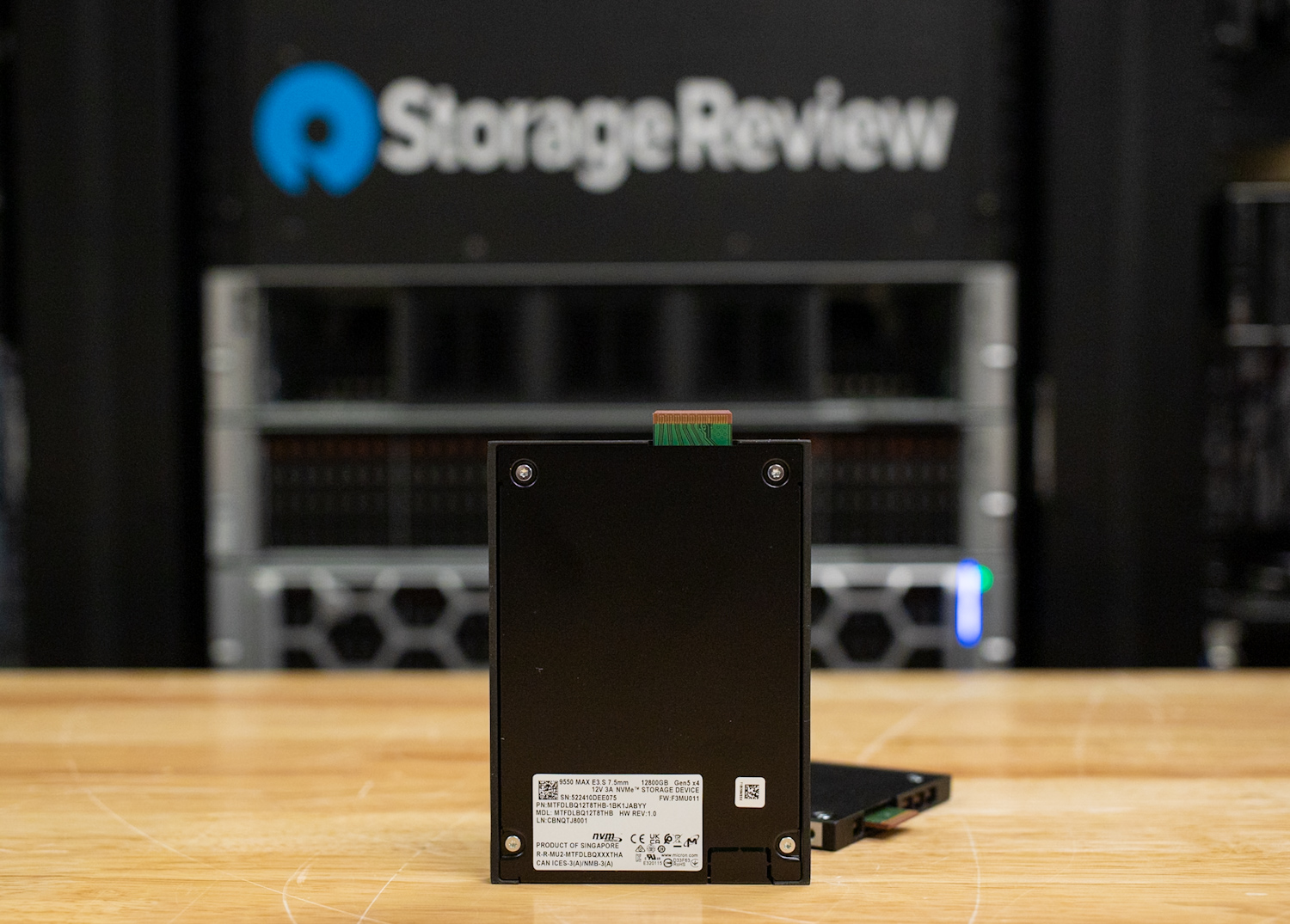
From a power and thermal standpoint, Micron specifies ≤18 W average RMS for sequential read and write operations, which fits squarely within typical front-bay cooling envelopes for U.2 and E3.S systems and helps preserve performance consistency during long, mixed workloads. The operating temperature is rated at 0–70 °C, giving admins comfortable headroom across a range of chassis airflow designs.
Reliability targets reflect the MAX line’s endurance focus: MTTF up to 2.5M hours (2.0M hours at higher ambient), UBER < 1e-17, and a five-year warranty. Capacities span 3.2TB to 25.6TB, and Micron publishes low typical latency figures (60 µs read / 15 µs write) alongside Gen5 throughput ratings (up to 14 GB/s read / 10 GB/s write) and substantial mixed-IO numbers. These characteristics matter more than peak specs in real mixed-use deployments.
Micron 9550 MAX Performance
Drive Testing Platform
We chose a Dell PowerEdge R760 running Ubuntu 22.04.02 LTS as our test platform for all workloads in this review. Equipped with Serial Cables’ Gen5 JBOF, it offers broad compatibility with U.2, E1.S, E3.S, and M.2 SSDs. Our test system configuration is outlined below.
- 2 x Intel Xeon Gold 6430 (32-Core, 2.1GHz)
- 16 x 64GB DDR5-4400
- 480GB Dell BOSS SSD
- Serial Cables Gen5 JBOF
Drives Compared
- Pascari X200P 7.68TB
- SanDisk SN861 7.68TB
- Solidigm PS1010 7.68TB
- Kingston DC3000ME 7.68TB
- Micron 7600 Max 6.4TB
DLIO Checkpointing Benchmark
To evaluate SSD real-world performance in AI training environments, we utilized the Data and Learning Input/Output (DLIO) benchmark tool. Developed by Argonne National Laboratory, DLIO is specifically designed to test I/O patterns in deep learning workloads. It provides insights into how storage systems handle challenges such as checkpointing, data ingestion, and model training. The chart below illustrates how both drives handle the process across 36 checkpoints. When training machine learning models, checkpoints are essential for periodically saving the model’s state, preventing loss of progress during interruptions or power failures. This storage demand requires robust performance, especially under sustained or intensive workloads. We used DLIO benchmark version 2.0 from the August 13, 2024, release.
To ensure our benchmarking reflected real-world scenarios, we based our testing on the LLAMA 3.1 405B model architecture. We implemented checkpointing using torch.save() to capture model parameters, optimizer states, and layer states. Our setup simulated an eight-GPU system, implementing a hybrid parallelism strategy with 4-way tensor parallelism and 2-way pipeline parallel processing distributed across the eight GPUs. This configuration yielded checkpoint sizes of 1,636 GB, reflecting the requirements for training modern large language models.
In this benchmark, the Micron 9550 MAX 12.8TB emerged as the clear leader. Across the full 18-checkpoint run, it maintained the lowest average completion times, ranging from 457 s to 575 s. The drive delivered exceptional stability with minimal variance between checkpoints, indicating a well-balanced firmware design optimized for mixed read/write workloads.
Following closely behind, the Micron 7600 MAX 6.4TB produced times between 459 s and 586 s. While its average remained competitive, the drive exhibited brief performance fluctuation between checkpoints 4 and 7 before stabilizing toward the end of the test. Despite that, it remained firmly within the top tier, showing excellent efficiency for sustained AI and HPC workloads.
The Micron 9550 7.68TB performed just behind the two flagship models, with results ranging from 458s to 582s. It maintained consistent scaling and remained competitive with the higher-end MAX drives, reinforcing the strength of the underlying Micron 9550 platform.
Among the other enterprise SSDs tested, the Solidigm PS1010, SanDisk SN861, and Kingston DC3000ME occupied the mid-range, completing most checkpoints in the 450s to 610s window. The Pascari X200P showed the least consistent performance, reaching over 690 seconds during the middle of the run before stabilizing towards the end.
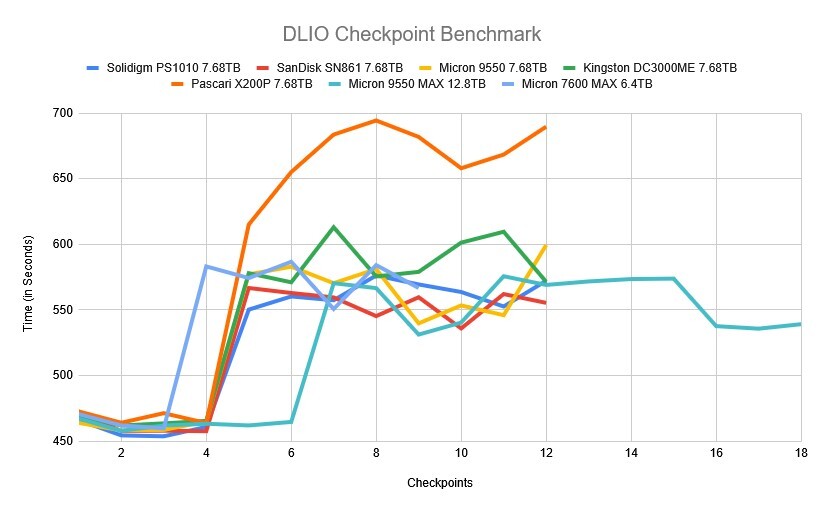
In this pass average test, the Solidigm PS1010 7.68TB led the group with the fastest average completion times, ranging from 458s to 564s across the three passes. The drive showed excellent consistency, maintaining low variance between runs and demonstrating strong efficiency under mixed I/O workloads.
The SanDisk SN861 7.68TB followed closely behind, posting nearly identical results with averages between 461 s and 553 s, confirming its ability to deliver reliable checkpointing performance with minimal degradation.
The Micron 9550 7.68TB followed, finishing between 461 s and 559 s across the same passes. Its performance remained very competitive, falling just behind the leaders while maintaining stable scaling and solid throughput through all iterations.
The Micron 9550 MAX 12.8TB and Micron 7600 MAX 6.4TB rounded out the top five, posting slightly higher averages of 462–555 s and 464–567 s, respectively. Both maintained consistent behavior over time but trailed the smaller-capacity Micron and the two leading drives from Solidigm and SanDisk.
Among the rest of the group, the Kingston DC3000ME and Pascari X200P had the highest overall times, averaging 580 s and 660 s, respectively. These results reflect a wider performance gap under sustained checkpointing conditions, particularly for workloads that require frequent writes to persistent storage.
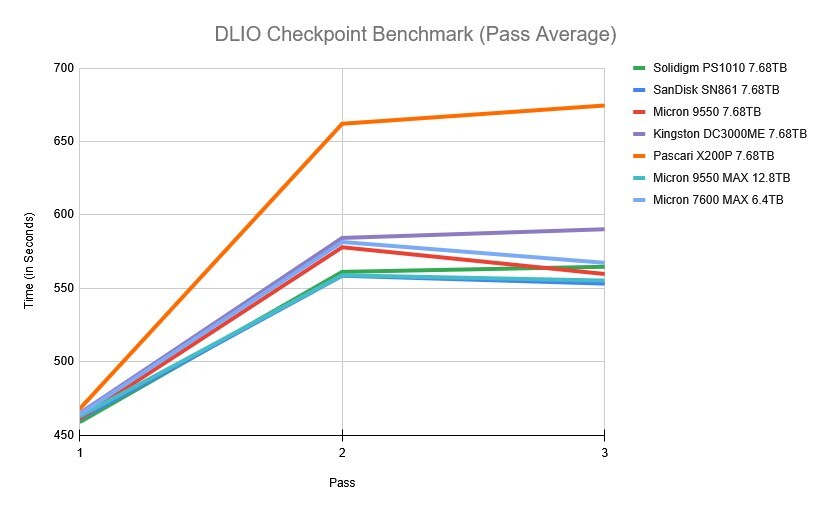
FIO Performance Benchmark
To measure the storage performance of each SSD across common industry metrics, we leverage FIO. Each drive undergoes the same testing process, which includes a preconditioning step of two full drive fills with a sequential write workload, followed by steady-state performance measurement. As each workload type being measured changes, we run another preconditioning fill of that new transfer size.
In this section, we focus on the following FIO benchmarks:
- 128K Sequential
- 64K Random
- 16K Random
- 4K Random
128K Sequential Write (IODepth 16 / NumJobs 1)
Moving into the 128K Sequential Write test, results were nearly identical to what we observed during preconditioning. The Micron 9550 Max (12.8TB) once again led by a wide margin, sustaining 10,957.9MB/s, holding firm at the top of the group. The Kingston DC3000ME (7.68TB) followed in second at 8,477.4MB/s, with the Pascari X200P (7.68TB) close behind at 8,369.7MB/s.
Trailing further back were the Solidigm PS1010 (7,126.5MB/s) and SanDisk DC SN861 (7,116.5MB/s), while the Micron 7600 Max (6.4TB) settled at the bottom of the chart with 6,960.6MB/s.
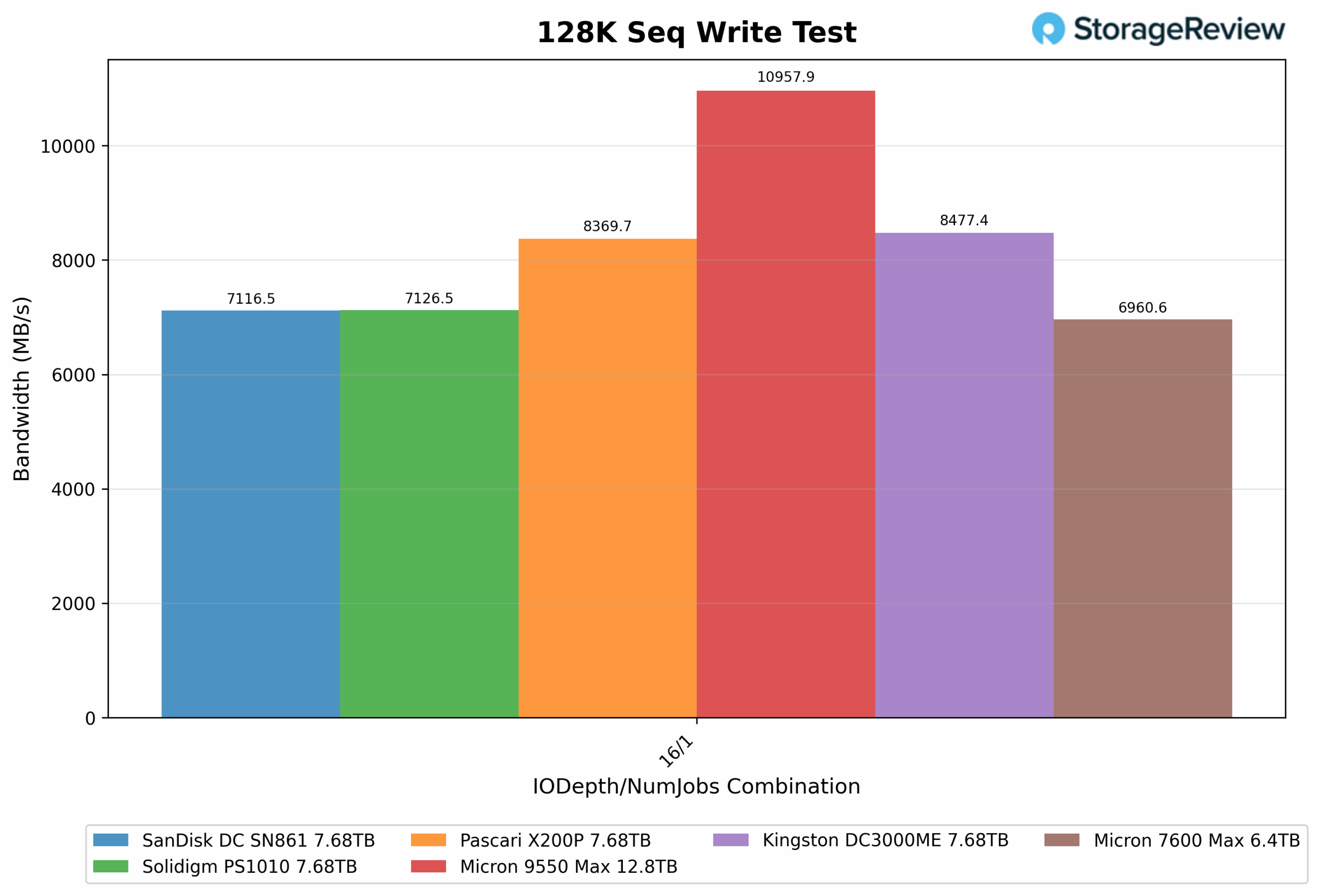
128K Sequential Write Latency (IODepth 16 / NumJobs 1)
Moving to latency, the 128K Sequential Write test was run at an IODepth of 16 with a single job, compared to the heavier 256 queue depth used in preconditioning. As expected, latency dropped significantly across all drives. The Micron 9550 Max (12.8TB) again led the field with the lowest latency at 0.18ms, showcasing its ability to sustain top-end throughput with minimal delay.
The Kingston DC3000ME (7.68TB) followed closely at 0.24ms, with the Pascari X200P (7.68TB) just behind at 0.24ms. Meanwhile, the Solidigm PS1010 (0.28ms) and SanDisk DC SN861 (0.28ms) posted similar results, while the Micron 7600 Max (6.4TB) landed at the back with 0.29ms.
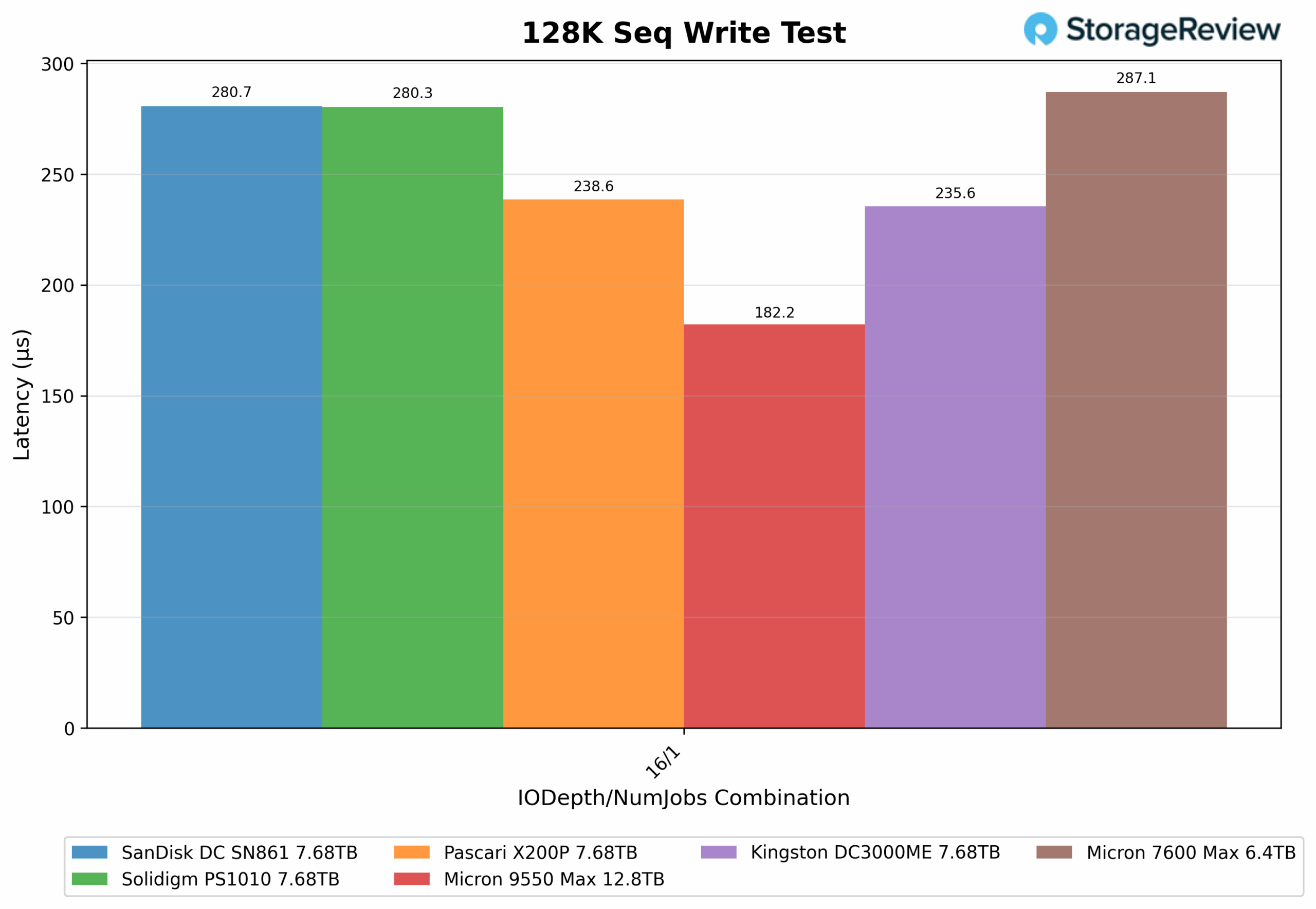
128K Sequential Read (IODepth 64 / NumJobs 1)
Transitioning to reads, the 128K Sequential Read test brought much closer results across the competing drives. The Pascari X200P (7.68TB) edged out the top spot at 14,242.1MB/s, just ahead of the Solidigm PS1010 (7.68TB) with 14,163.3MB/s, and the Micron 9550 Max (12.8TB) right behind at 14,047.5MB/s. These three drives effectively landed within a narrow margin, showing minimal real-world differences in sustained sequential read throughput.
The Kingston DC3000ME (7.68TB) trailed the leading trio slightly at 13,513.8MB/s, while the SanDisk DC SN861 (7.68TB) delivered 12,631.2MB/s. At the lower end, the Micron 7600 Max (6.4TB) came in at 11,240.5MB/s, marking the only drive in the group to fall below the 12GB/s threshold.
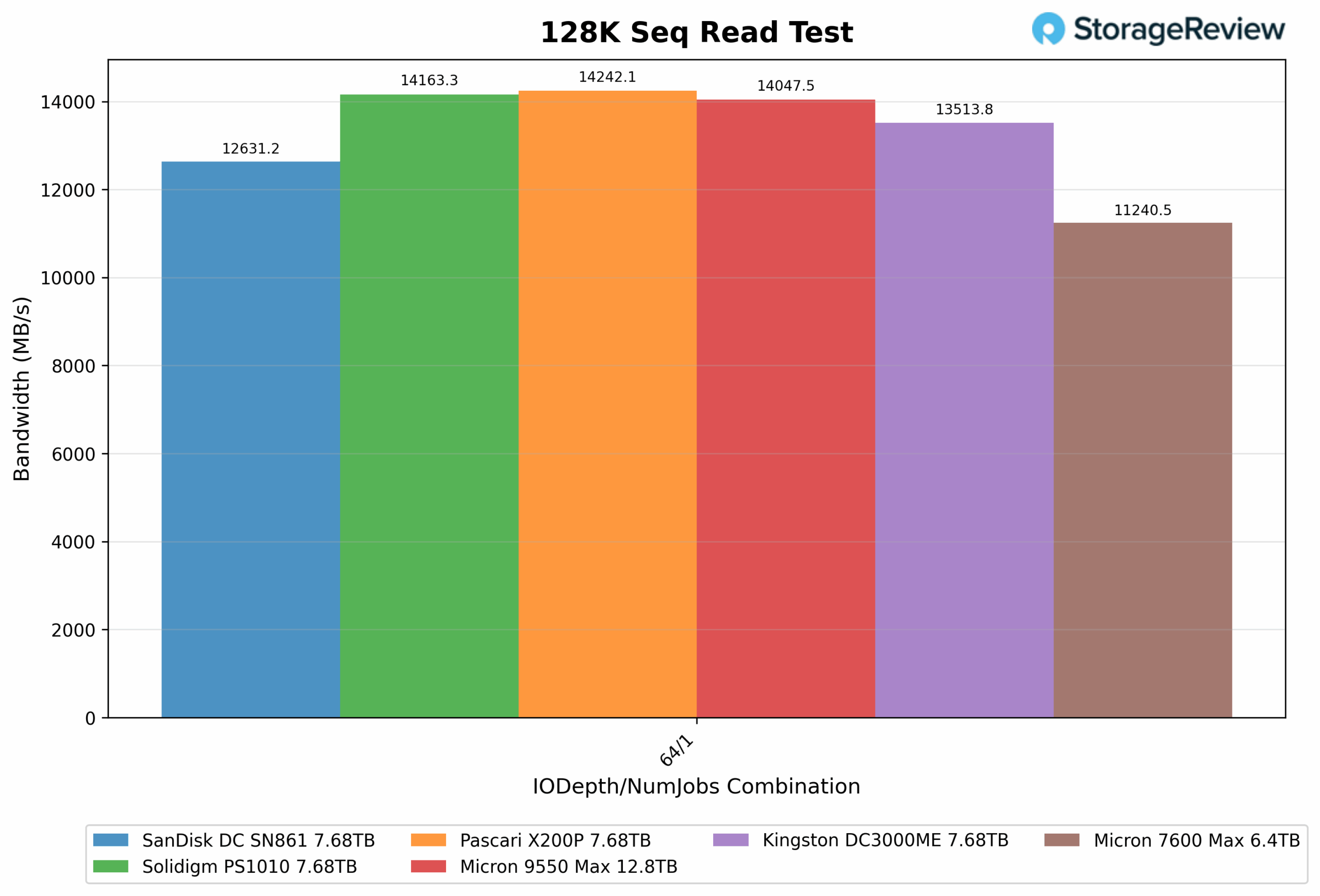
128K Sequential Read latency (IODepth 64 / NumJobs 1)
Looking at latency, the 128K Sequential Read test (IODepth 64 / NumJobs 1) highlighted just how tight the competition was among the top performers. The Pascari X200P (7.68TB) led with 0.56ms, nearly matched by the Solidigm PS1010 (0.56ms) and the Micron 9550 Max (12.8TB) at 0.57ms. These three drives were effectively tied, echoing the narrow spread we saw in throughput.
The Kingston DC3000ME (7.68TB) followed with 0.59ms, while the SanDisk DC SN861 (7.68TB) landed at 0.63ms. The Micron 7600 Max (6.4TB) came in last with 0.71ms, consistent with its lower sequential read bandwidth.
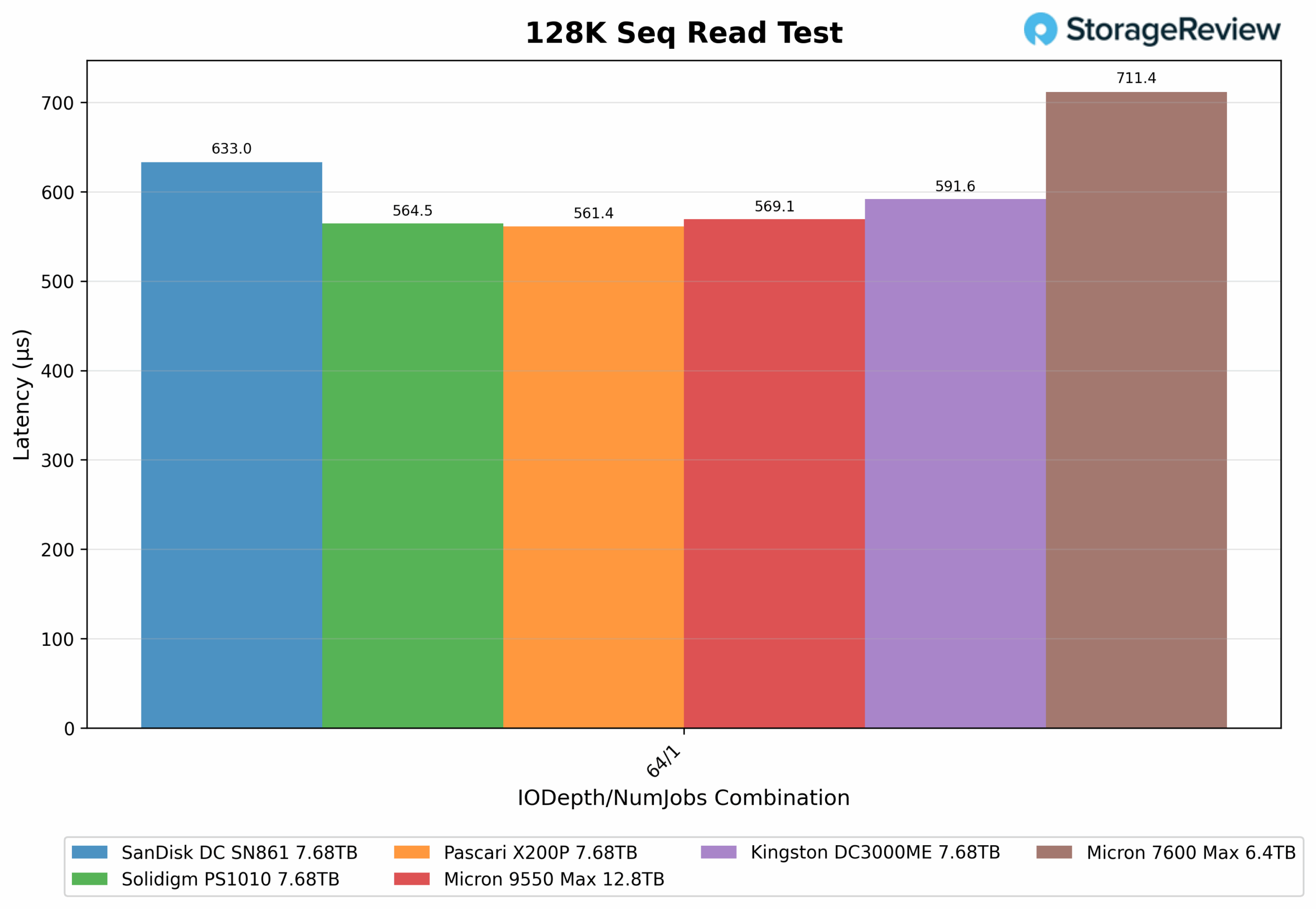
64K Random Write
In the 64K Random Write test, the Micron 9550 Max (12.8TB) demonstrated a wide performance range, from lows around 2.45GB/s up to a peak of 10.6GB/s, with an average of 7.34GB/s across the sweep. This not only made it the top performer but also the only drive to consistently scale past the 10GB/s mark at higher queue depths. Micron 7600 Max (6.4TB) showed solid consistency but with a lower performance ceiling, ranging from 2.39GB/s to 6.8GB/s, and averaging 5.16GB/s. This put it firmly in the second tier, behind the 9550 Max but ahead of most other competitors in the chart.
Looking at the rest of the field, the Kingston DC3000ME (7.68TB) and SanDisk DC SN861 (7.68TB) settled into the 4-6GB/s range, generally competitive but unable to scale to the Micron levels. The Solidigm PS1010 (7.68TB) and Pascari X200P (7.68TB) landed in the lower tier, often clustering in the 2-4GB/s range, trailing both Micron drives by a significant margin.
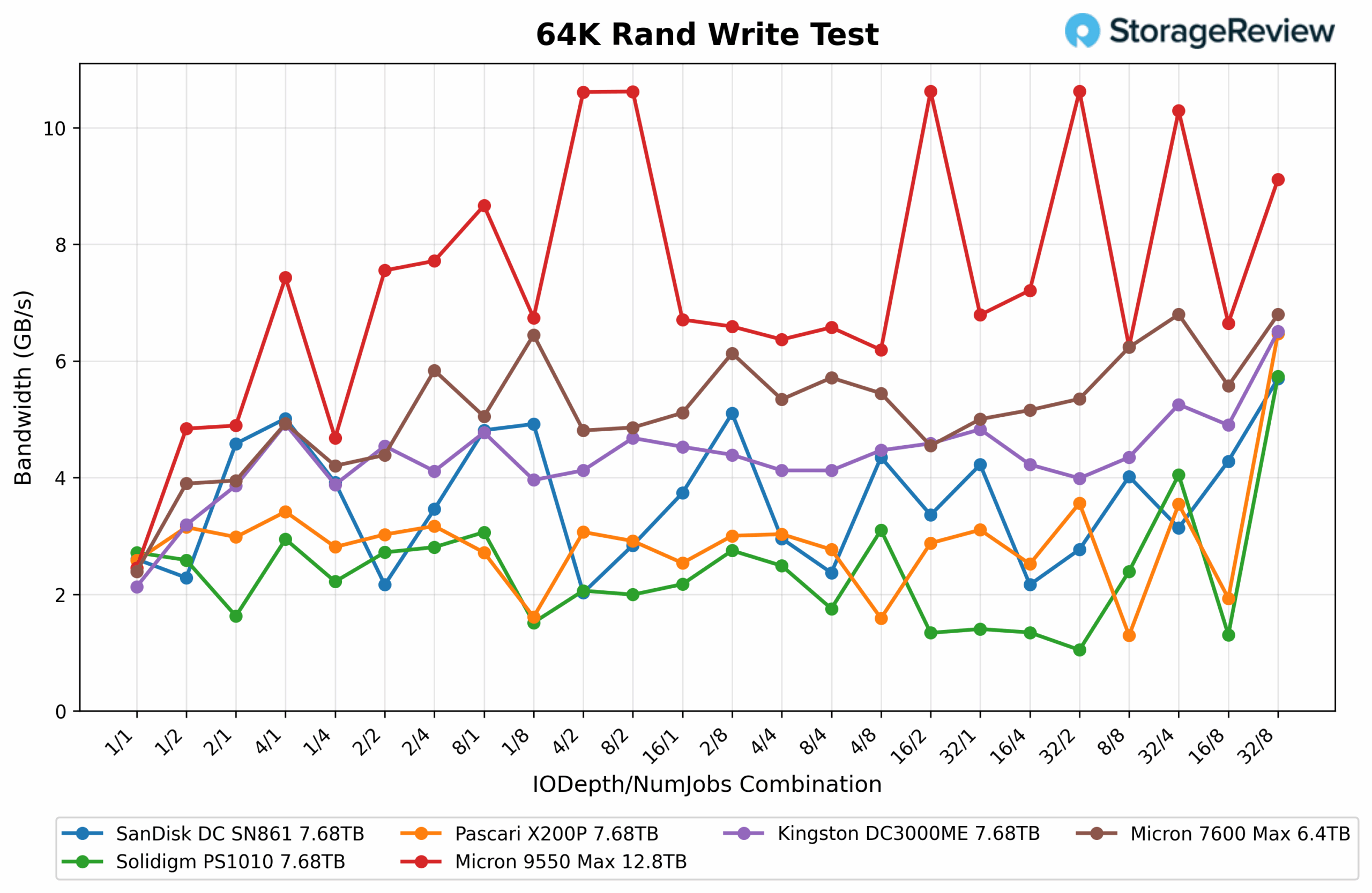
64K Random Write Latency
In terms of latency, the Micron 9550 Max (12.8TB) delivered the most consistent results, averaging just 0.30ms with peaks under 1.71ms even at heavier queue depths. The Micron 7600 Max (6.4TB) followed with a slightly higher average of 0.41ms and a maximum of 2.3ms, still maintaining reasonable control under load. The Kingston DC3000ME and SanDisk DC SN861 fell into the middle tier, with latency generally ranging from 0.05ms up to 2.7ms. At the same time, the Pascari X200P and Solidigm PS1010 showed the most significant volatility, reaching 4.1ms and 6.0ms, respectively, at higher queue depths.
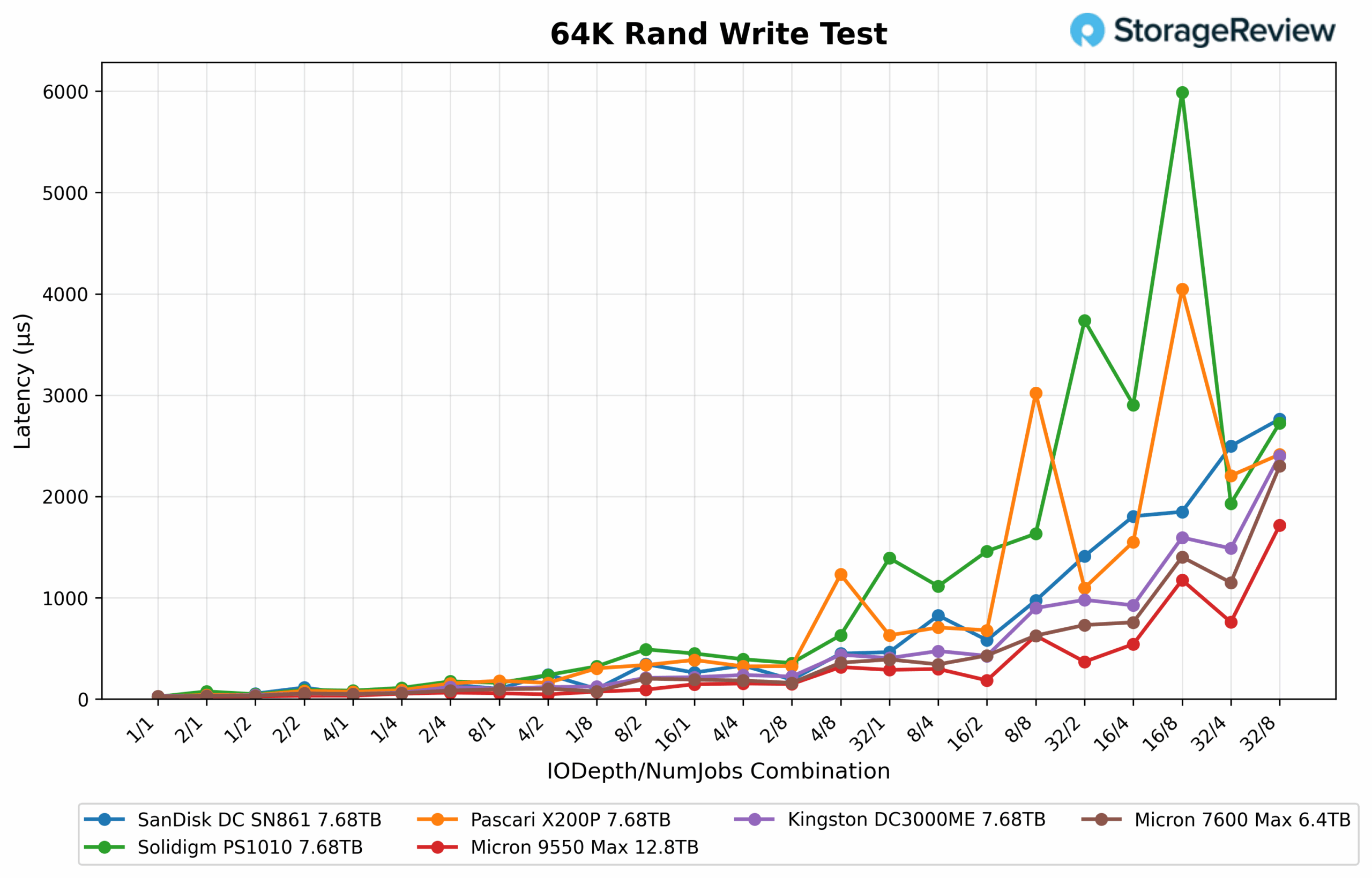
64K Random Read
In the 64K Random Read test, both Micron drives posted strong results with very close averages. The Micron 9550 Max (12.8TB) ranged from 0.49GB/s at the low end up to a peak of 13.7GB/s, with an average of 6.96GB/s. The Micron 7600 Max (6.4TB) showed a similar profile, starting slightly higher at 0.61GB/s, peaking at 11.0GB/s, and averaging 6.94GB/s across the sweep.
From the broader chart, we see that drives like the Solidigm PS1010 and Pascari X200P were able to push into the 13-14GB/s range at higher queue depths, giving them a slight edge in peak throughput over the Microns. The Kingston DC3000ME followed closely behind in the 12-13GB/s range, while the SanDisk DC SN861 trailed slightly lower, leveling out around 12.3GB/s.
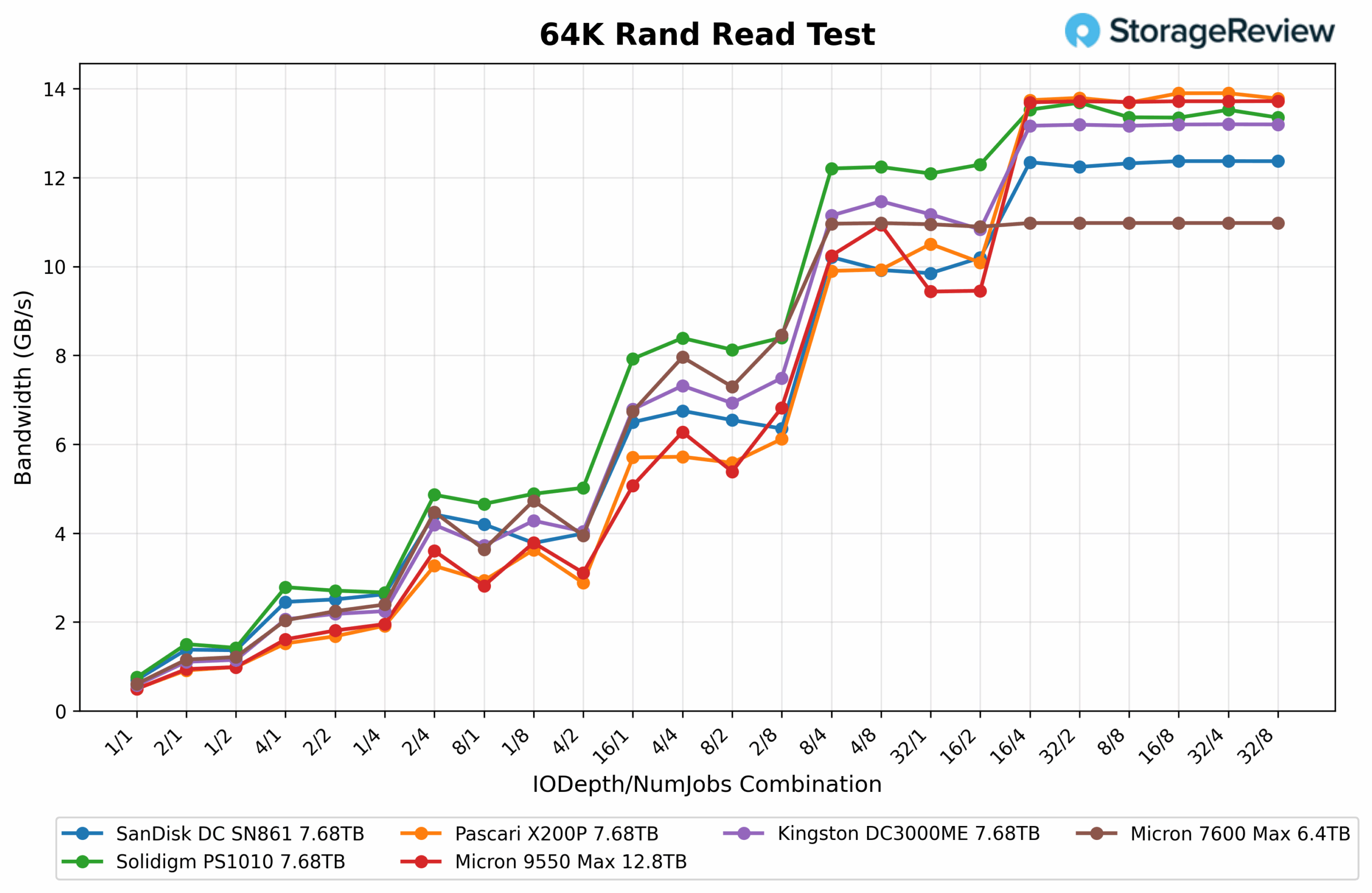
64K Random Read Latency
In the 64K Random Read test, the Micron 9550 Max (12.8TB) maintained a strong latency profile, averaging 0.25ms, with lows of 0.12ms and peaks up to 1.14ms under heavier loads. The Micron 7600 Max (6.4TB) posted very similar figures, averaging 0.26ms, dipping as low as 0.10ms, but climbing slightly higher to a maximum of 1.42ms. Both Microns delivered stable latency overall, staying tightly grouped with the rest of the field for much of the run.
Looking across the chart, the Solidigm PS1010 and Pascari X200P showed slightly higher latencies in bursts, generally tracking between 0.1 and 1.2ms. At the same time, the Kingston DC3000ME and SanDisk DC SN861 followed closely in the same range, peaking just over 1.2ms. Among all tested drives, the Microns remained competitive and consistent, with only minor differences separating them from the rest of the top tier.
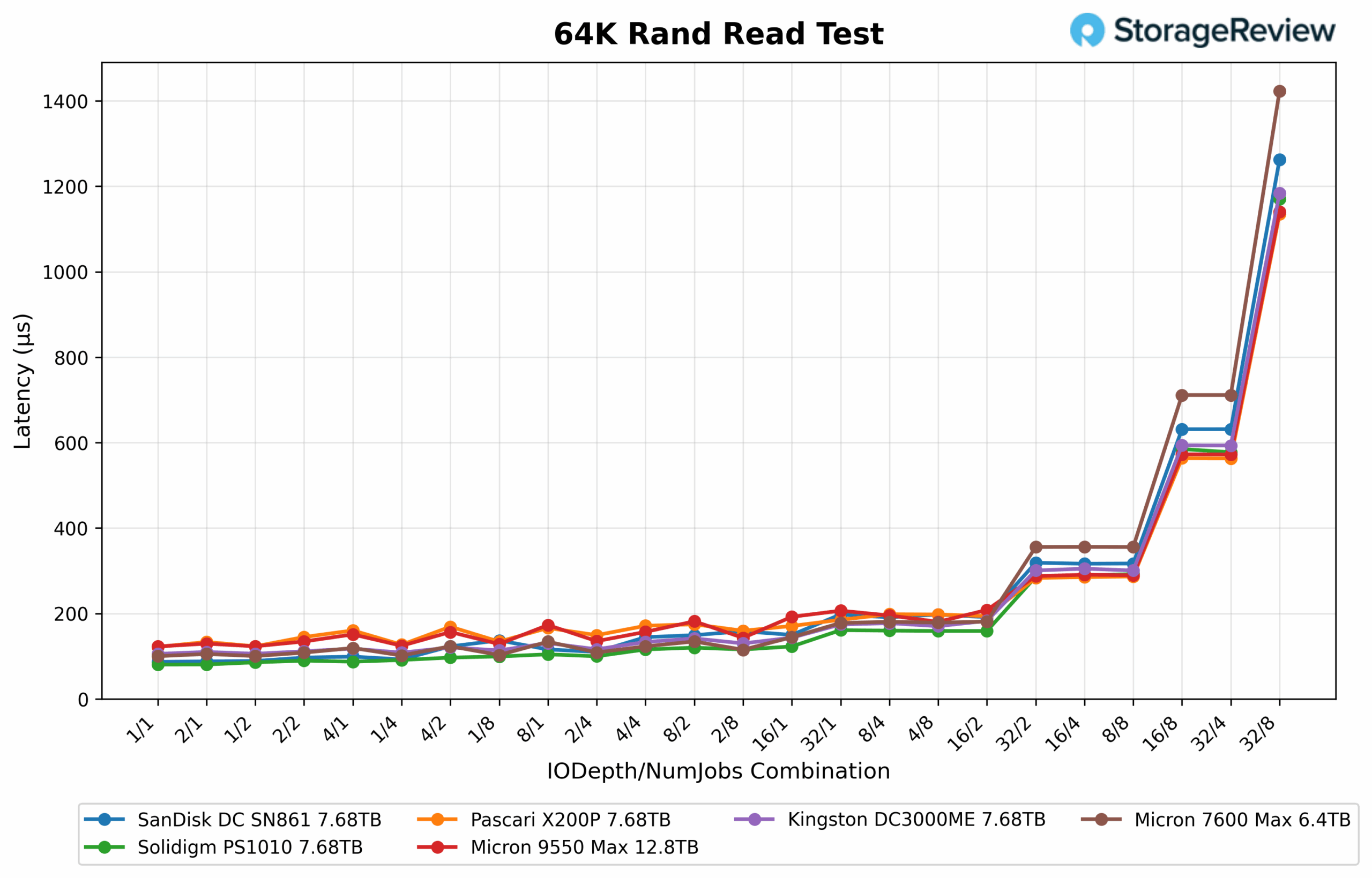
16K Sequential Write
In the 16K Sequential Write test, the Micron 9550 Max (12.8TB) once again dominated, with throughput ranging from 0.85GB/s at the starting low end up to a peak of 10.7GB/s, and averaging 7.75GB/s across the sweep. The Micron 7600 Max (6.4TB) followed with a narrower performance band, ranging from 0.84GB/s to 6.8GB/s, averaging 5.63GB/s, which put it firmly behind the 9550 but still ahead of most other drives.
From the broader chart, the Kingston DC3000ME and Pascari X200P clustered in the 6-8GB/s range at higher queue depths, trading blows but generally trailing the 9550 Max. The Micron 7600 Max also tracked in this tier, but leaned toward the lower end of the spread. The Solidigm PS1010 settled slightly lower in the 5-6GB/s range, while the SanDisk DC SN861 showed the weakest performance overall, often falling below 4GB/s and dipping as low as 1GB/s.
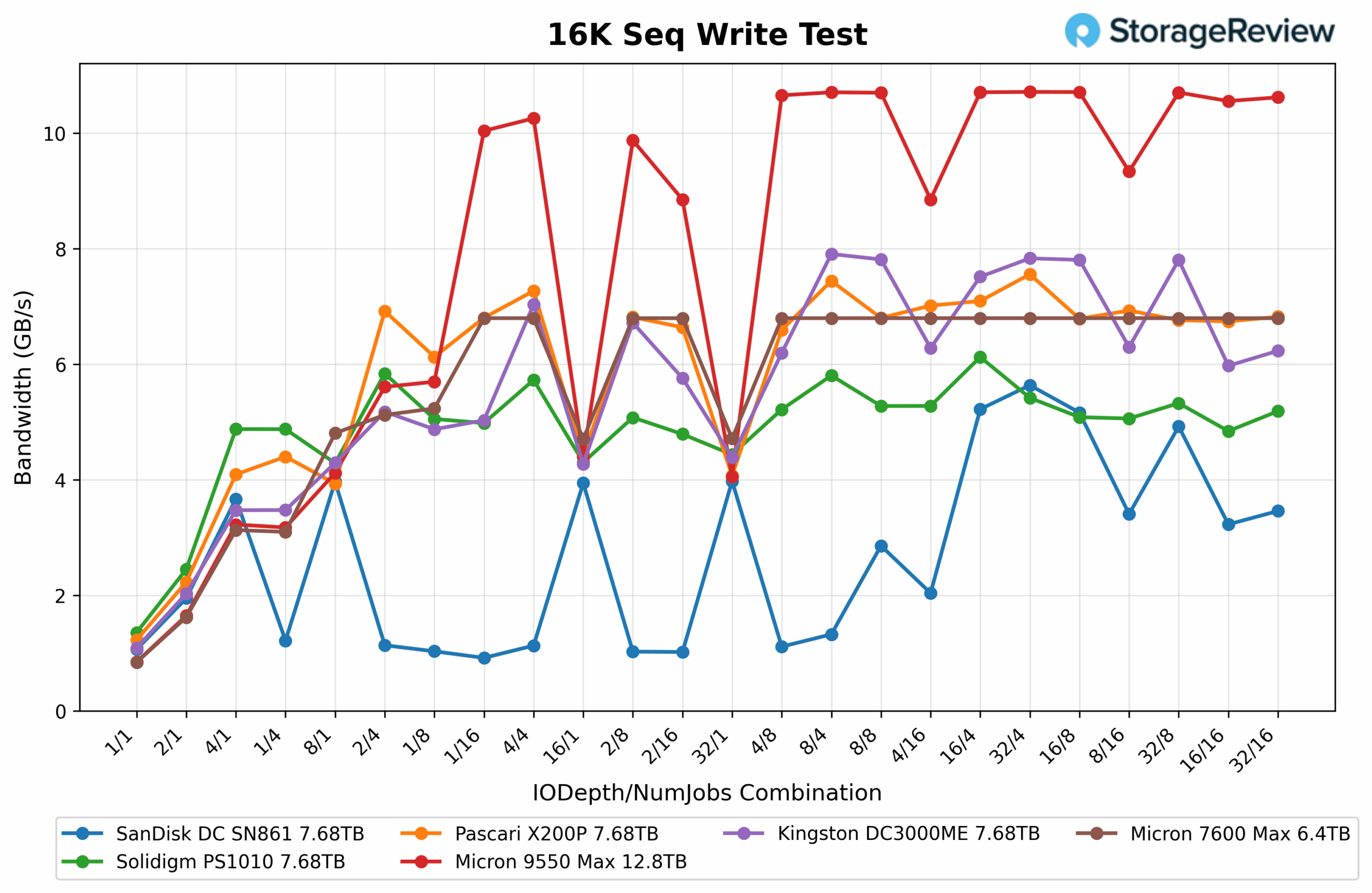
16K Sequential Write Latency
In the 16K Sequential Write latency test, the Micron 9550 Max (12.8TB) again demonstrated excellent responsiveness, with latency averaging 0.12ms, dipping to 0.018ms, and peaking at 0.75ms under load. The Micron 7600 Max (6.4TB) followed with a slightly higher average of 0.18ms, a similar minimum of 0.018ms, and peaks reaching 1.15ms.
Looking at the chart, the Kingston DC3000ME and Pascari X200P remained in the mid-tier, generally ranging between 0.05–1.2ms, while the Solidigm PS1010 crept higher, pushing past 1.5ms at the upper queue depths. The SanDisk DC SN861 showed the weakest latency profile overall, climbing above 2.0ms under stress.
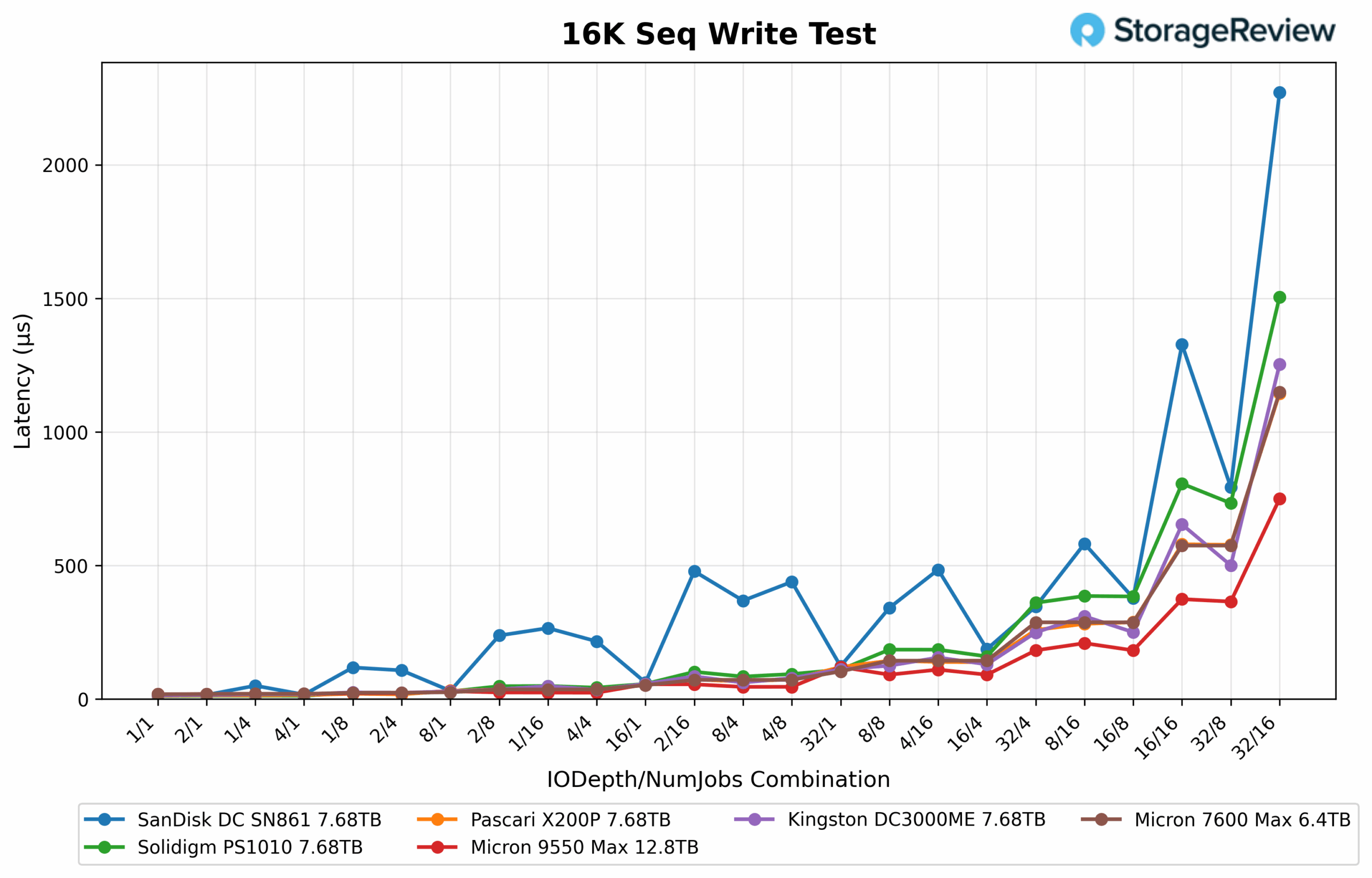
16K Sequential Read
In the 16K Sequential Read test, both Micron drives delivered solid performance with slightly different profiles. The Micron 9550 Max (12.8TB) ranged from 1.02GB/s at the low end up to a peak of 12.5GB/s, with an average throughput of 5.59GB/s. The Micron 7600 Max (6.4TB) started similarly at 1.03GB/s, peaked at 11.0GB/s, and averaged slightly higher at 6.08GB/s across the sweep, putting it marginally ahead of the 9550 Max in terms of consistency over the full run.
From the broader chart, the Kingston DC3000ME surged to the front of the pack at higher queue depths, briefly topping 12.8GB/s, while the Pascari X200P and Solidigm PS1010 pushed into the 12GB/s range as well. The SanDisk DC SN861 trailed the group slightly, settling just below 10GB/s at the upper end.
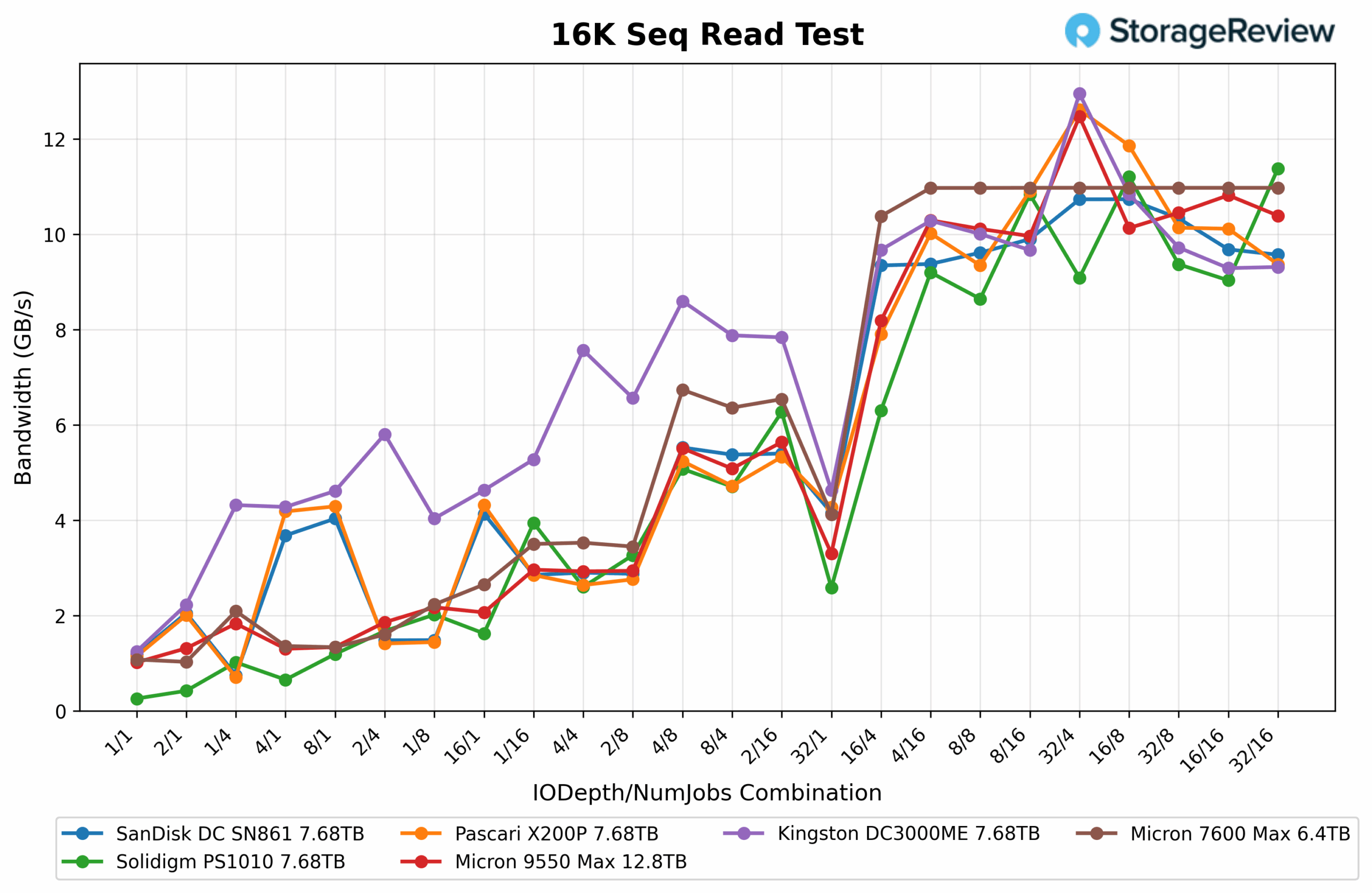
16K Sequential Read Latency
In the 16K Sequential Read test, the Micron 9550 Max (12.8TB) showed a latency profile ranging from 0.015ms at the low end to a peak of 0.78ms, with an average of 0.15ms across the sweep. The Micron 7600 Max (6.4TB) performed slightly tighter, starting at 0.014ms, peaking at 0.71ms, and averaging 0.13ms, giving it a slight efficiency advantage over its larger sibling.
Looking at the chart, the Kingston DC3000ME and Pascari X200P followed a similar mid-range pattern, averaging in the 0.1-0.2ms range with peaks just above 0.8ms. The Solidigm PS1010 was slightly more erratic, reaching 0.75ms, while the SanDisk DC SN861 generally tracked Kingston closely but showed greater variability as queue depths increased.
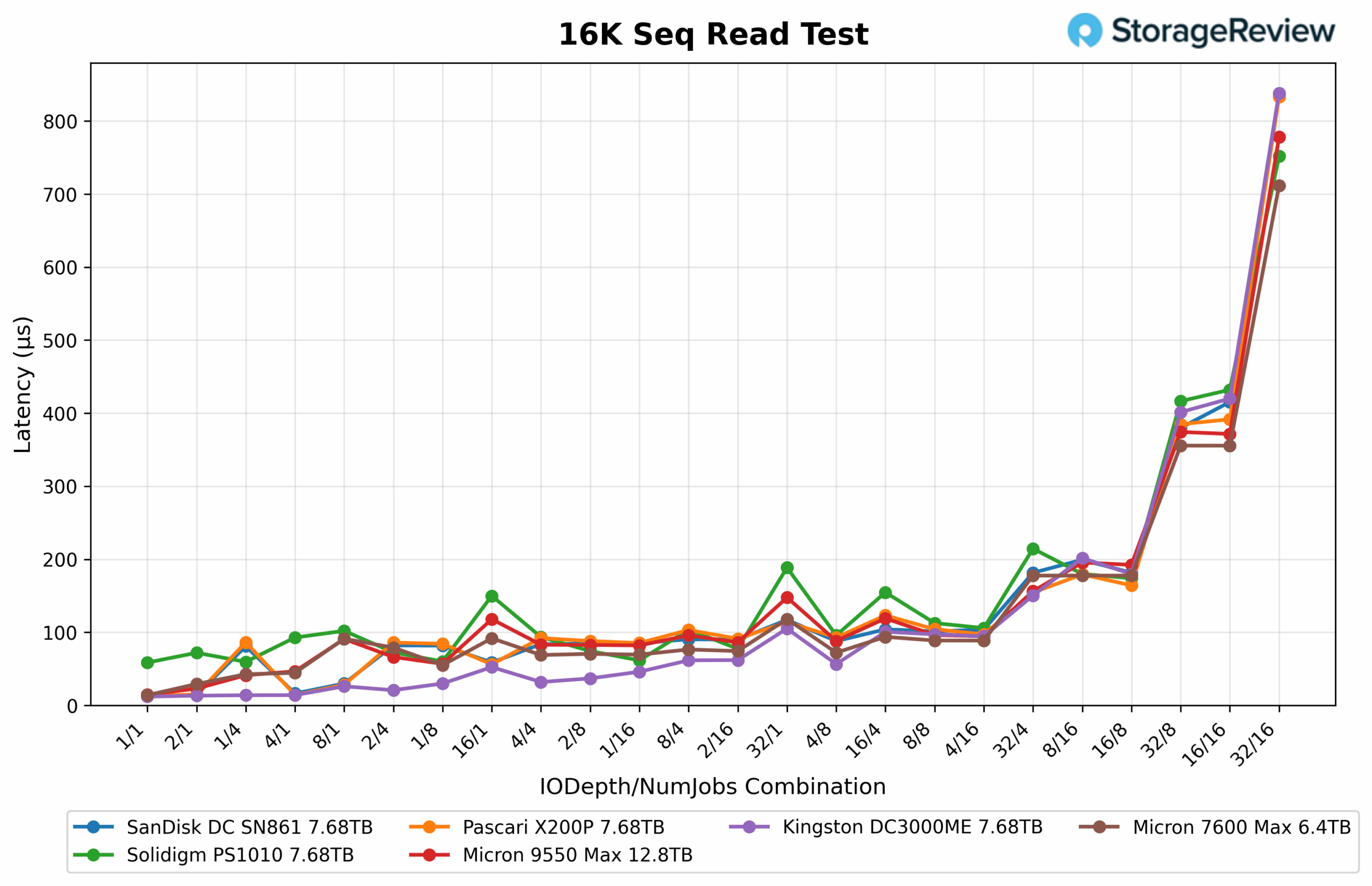
16K Random Write
In the 16K Random Read test, the Micron 9550 Max (12.8TB) achieved a peak of just over 900K IOPS, with lows around 18K IOPS and an average throughput of roughly 420K IOPS across the sweep. The Micron 7600 Max (6.4TB) demonstrated more consistency, but its maximum scaling was slightly lower, peaking at about 720K IOPS. It ranged from 17K IOPS at the lowest point to approximately 350K IOPS overall.
From the chart, the Pascari X200P and Solidigm PS1010 both scaled impressively, with the Pascari closely matching the Micron 9550 Max at the top end and cresting just below 900K IOPS, while Solidigm settled in the 820–850K IOPS range. The Kingston DC3000ME initially tracked closely with the leaders but peaked at around 620K IOPS as scaling progressed. The SanDisk DC SN861 lagged, finishing just over 500K IOPS.
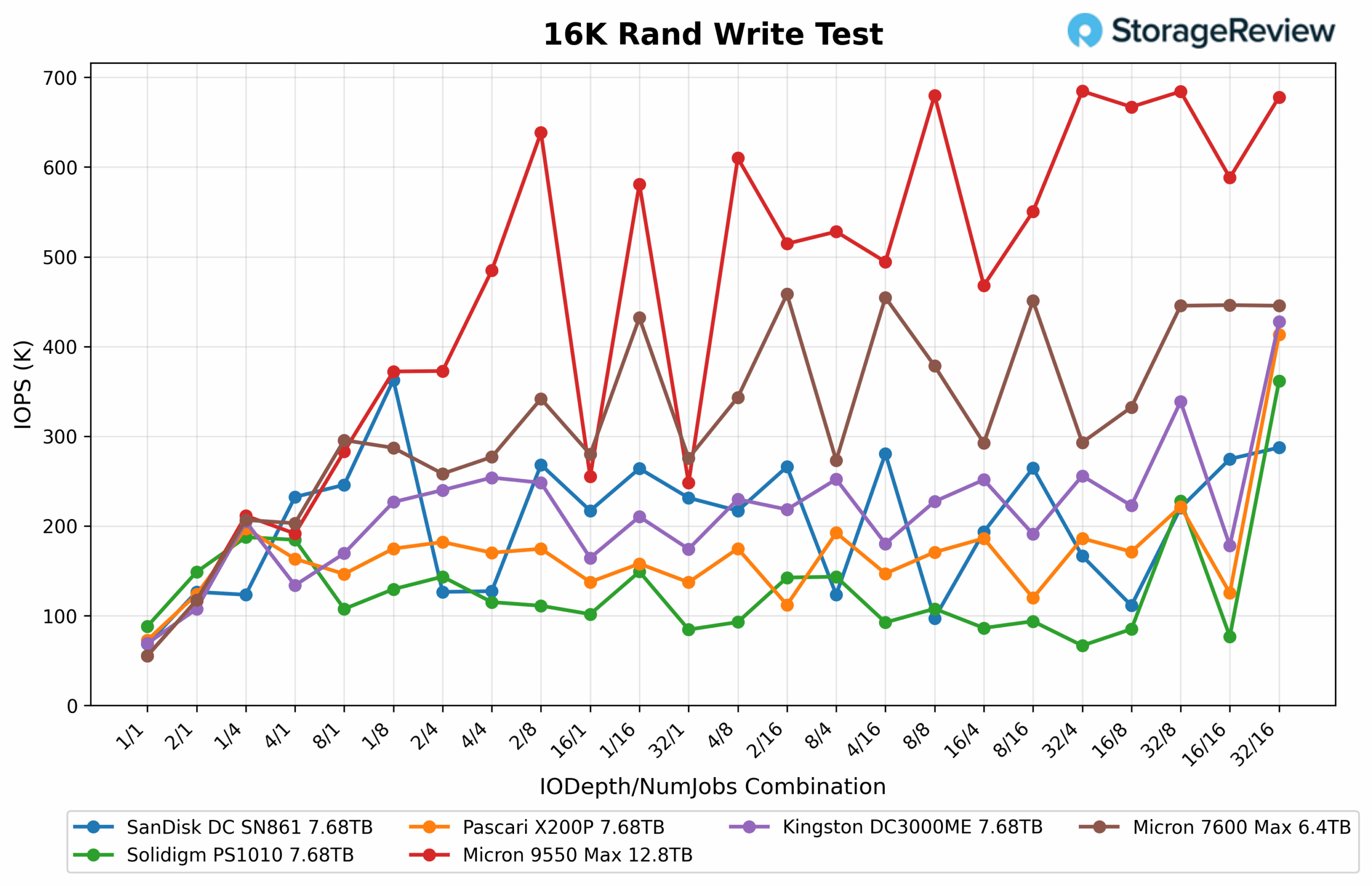
16K Random Write Latency
In the 16K Random Write test, the Micron 9550 Max (12.8TB) again showed the strongest latency discipline, staying between 0.015ms and 0.77ms, with an average of 0.13ms across the sweep. The Micron 7600 Max (6.4TB) was slightly less aggressive, with a range of 0.016ms to 1.26ms and an average of 0.21ms. This positioned the 9550 Max as the most efficient under pressure, with the 7600 Max still holding a competitive profile compared to the rest of the pack.
From the chart, the Kingston DC3000ME and Pascari X200P settled into the middle tier, typically running in the 0.2–1.5ms range, while the SanDisk DC SN861 spiked more heavily under high queue depths, breaching 1.8ms. The Solidigm PS1010 struggled most in this test, hitting latencies well above 3ms at its worst points, showing difficulty maintaining consistency at scale.
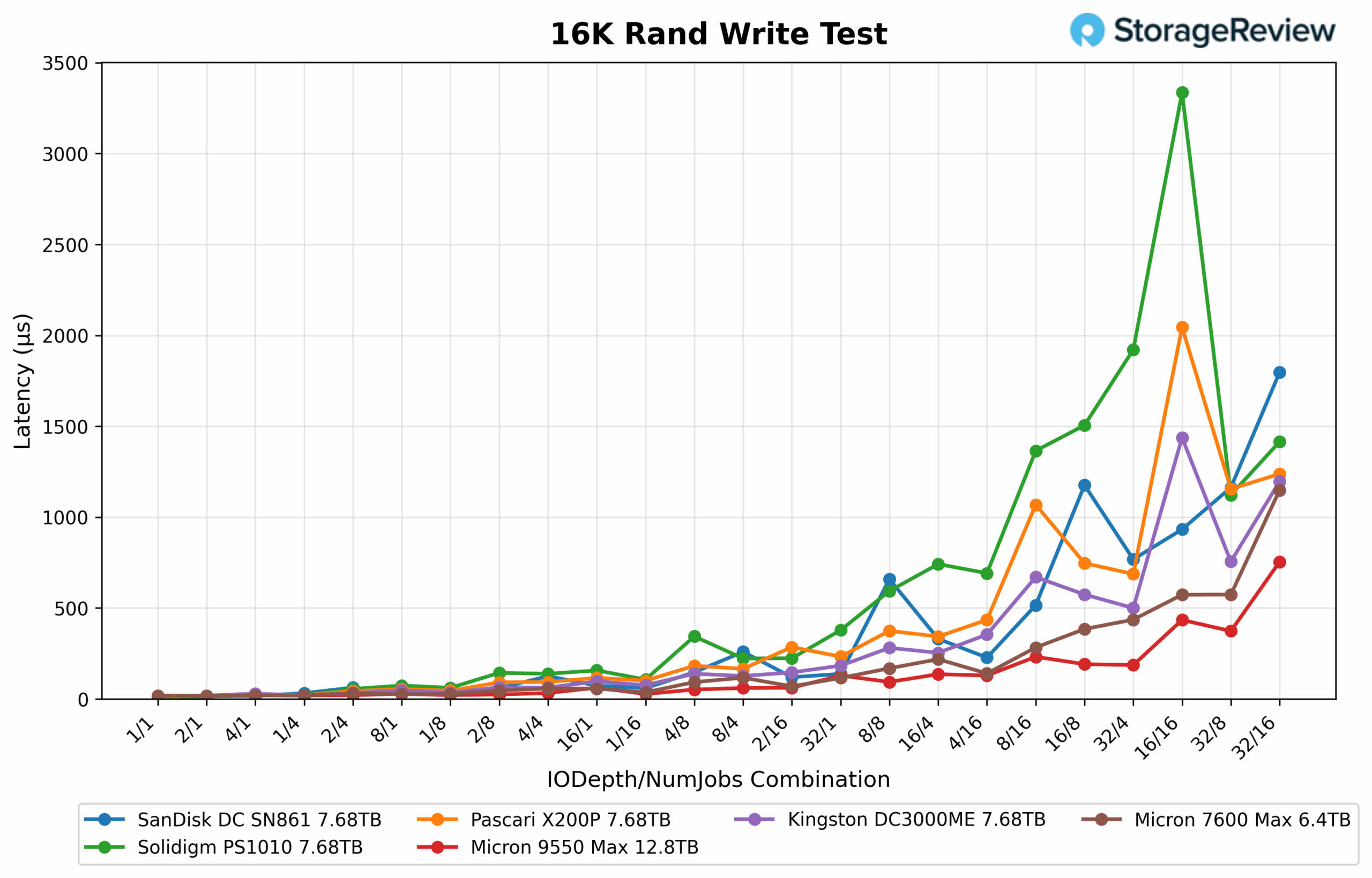
16K Random Read
In the 16K Random Read test, the Micron 9550 Max (12.8TB) delivered a wide range of performance, starting at roughly 16.7K IOPS and scaling to a peak of 904K IOPS, with an average throughput of 433K IOPS across the sweep. The Micron 7600 Max (6.4TB) showed slightly lower scaling but strong consistency, ranging from 17.1K IOPS up to 720K IOPS, averaging 362K IOPS overall.
Looking across competitors, the Pascari X200P matched the Micron 9550 almost stride-for-stride, achieving a near-identical 900K IOPS peak. The Solidigm PS1010 trailed just slightly behind, cresting in the 820–850K IOPS range, while the Kingston DC3000ME plateaued earlier, maxing out at around 620K IOPS. The SanDisk DC SN861 rounded out the group at just over 500K IOPS, showing weaker scaling at higher queue depths.
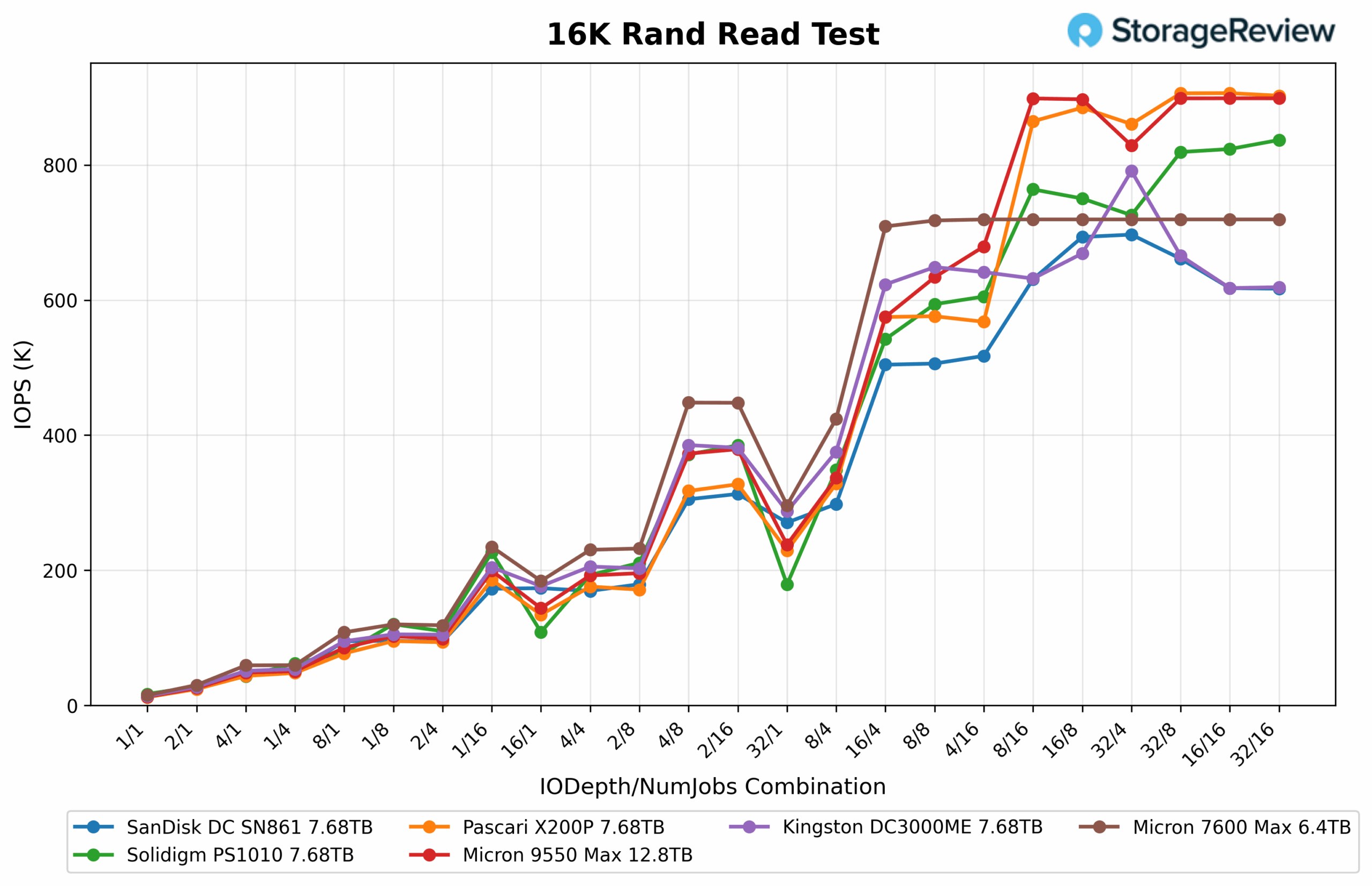
16K Random Read Latency
In the 16K Random Read test, the Micron 9550 Max (12.8TB) offered a latency profile ranging from 0.073ms at the low end to 0.57ms at peak, with an average of 0.12ms across the run. The Micron 7600 Max (6.4TB) tracked similarly but reached slightly higher at scale, starting at 0.065ms, peaking at 0.71ms, and averaging 0.14ms. Both Microns delivered stable, low-latency responses, with the 9550 Max showing the tighter curve at higher queue depths.
From the rest of the field, the Pascari X200P and Kingston DC3000ME remained competitive in the middle band, generally between 0.1–0.3ms for much of the test before pushing toward the 0.8ms range at the top end. The SanDisk DC SN861 and Solidigm PS1010 exhibited higher variability, with Solidigm in particular showing spikes approaching 0.6ms–0.65ms, putting them behind the Micron and Pascari leaders.
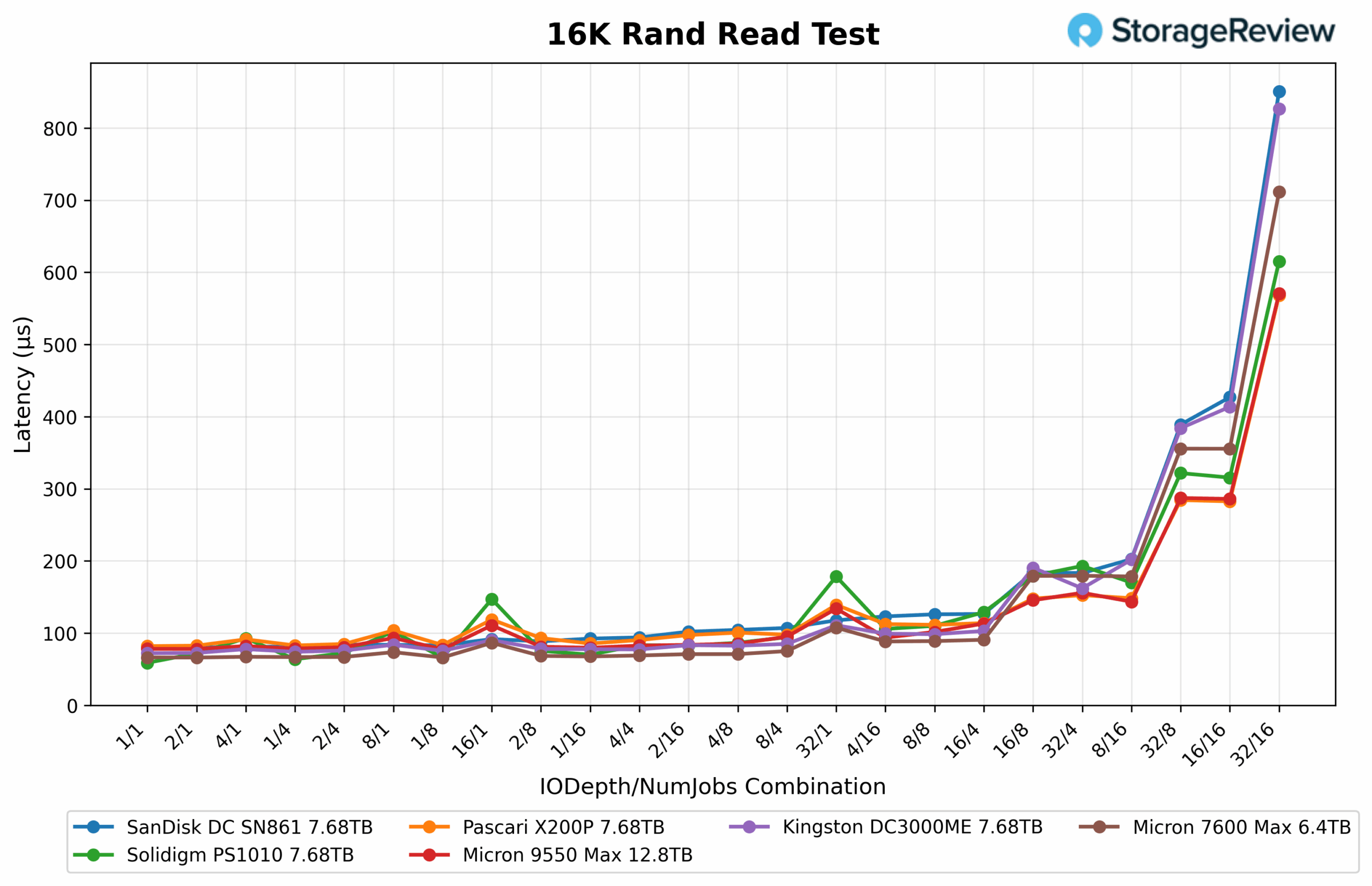
4K Random Write
In the 4K Random Write test, the Micron 9550 Max (12.8TB) led the pack, delivering 320K-1.56M IOPS, with steady scaling across the sweep and strong consistency at high queue depths. The Micron 7600 Max (6.4TB) closely followed, showing impressive acceleration past the mid-range and peaking slightly higher at 1.78M IOPS, making it the most aggressive scaler in this test. Both Micron drives demonstrated enterprise-class control under load, with smooth progression and minimal dips between thread combinations.
Among competitors, the SanDisk DC SN861 and Kingston DC3000ME performed well but trailed behind the Micron drives, topping out near 1.3M IOPS and 960K IOPS, respectively. The Pascari X200P displayed moderate consistency, reaching around 1.6M IOPS at its peak, while the Solidigm PS1010 lagged considerably, failing to maintain stability above 550K IOPS in most high-depth scenarios.
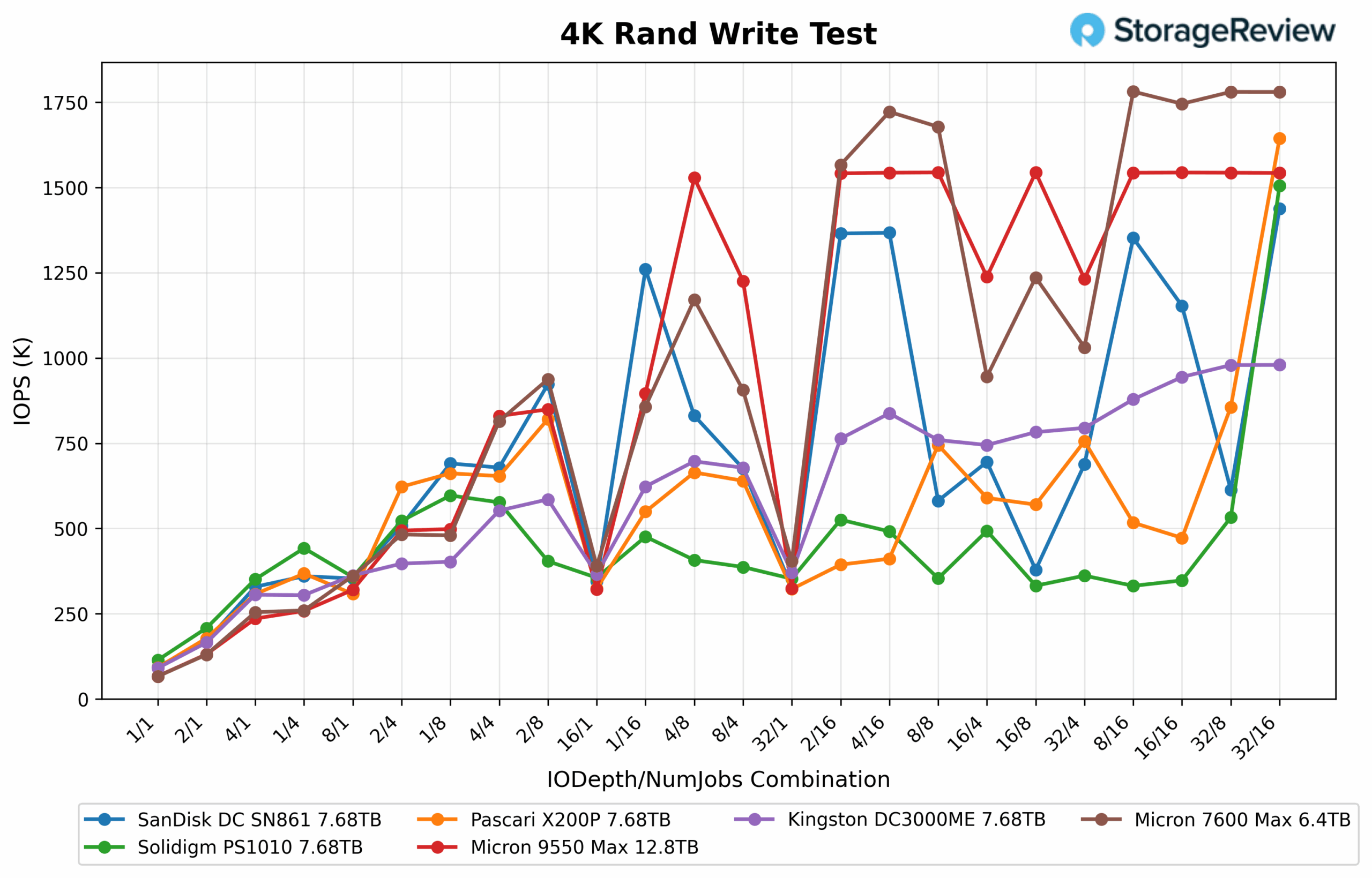
4K Random Write Latency
In the 4K Random Write test, the Micron 9550 Max (12.8TB) showcased excellent latency control, ranging from just 0.013ms at the low end to 0.37ms at peak, with an average of 0.06ms across the sweep. The Micron 7600 Max (6.4TB) followed closely, starting at 0.012ms and climbing to 0.29ms, averaging 0.05ms overall. Both drives delivered consistently low response times, with the 9550 Max showing slightly greater stability at higher queue depths.
From the chart, the Kingston DC3000ME and Pascari X200P showed higher variability, often sitting in the 0.1-0.5ms band and peaking above 0.5ms at the top end. The SanDisk DC SN861 landed in a similar range with some mid-run spikes. At the same time, the Solidigm PS1010 suffered the most, showing volatility and spikes exceeding 0.7ms, putting it behind the rest of the group in responsiveness.
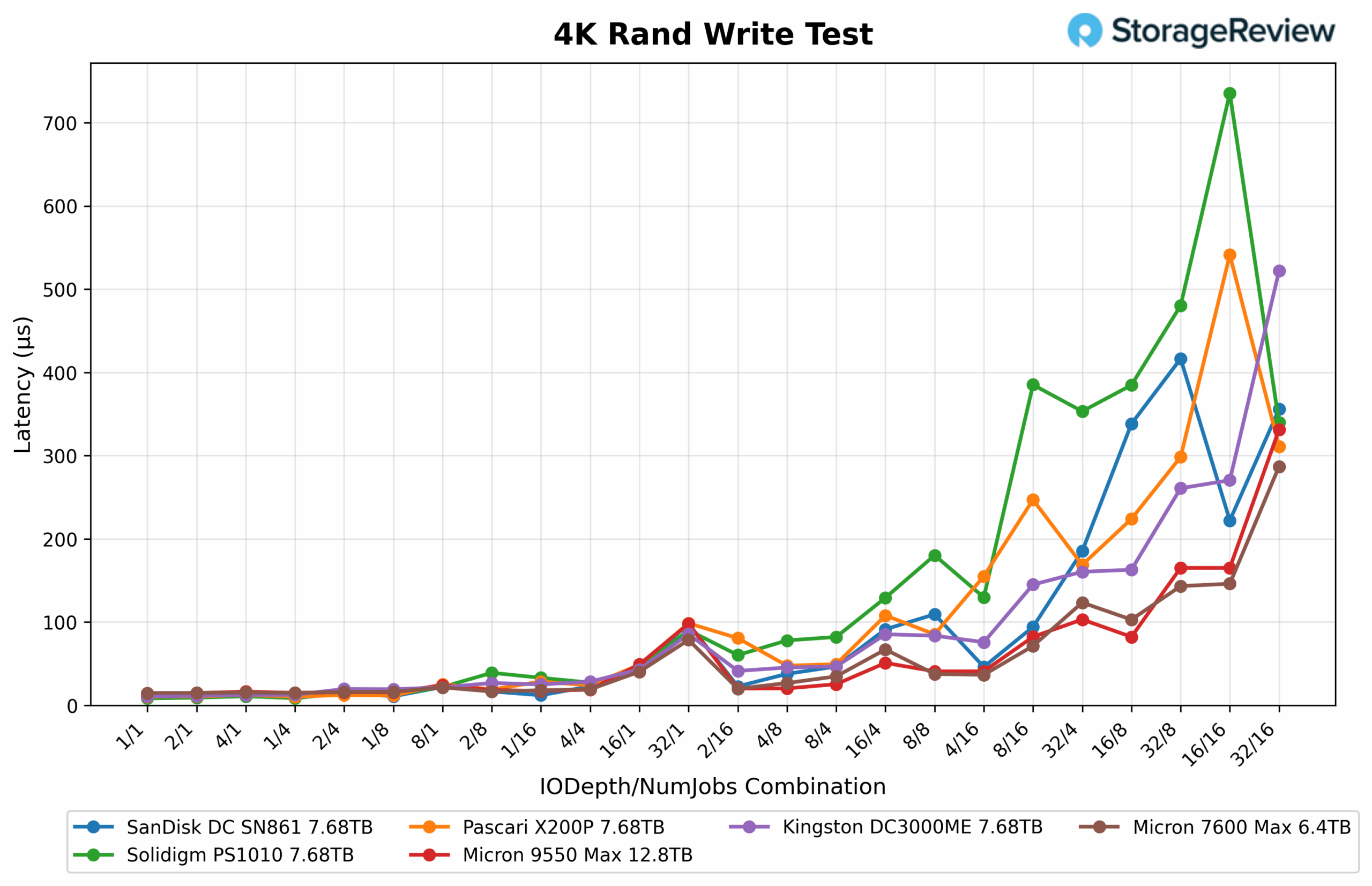
4K Random Read
In the 4K Random Read test, the Micron 9550 Max (12.8TB) reached as high as 2.2M IOPS, averaging about 1.3M IOPS across the sweep. The Micron 7600 Max (6.4TB) closely followed, peaking at just over 2.0M IOPS and averaging 1.4M IOPS, showing excellent scaling under load. Both Micron drives were very competitive, trading the lead depending on queue depth and thread count.
The chart shows that the SanDisk DC SN861 surged to the extreme, climbing beyond 2.5M IOPS, but it also showed significant variability, with dips under heavy load. The Pascari X200P and Kingston DC3000ME both settled in the 2.0M IOPS range at peak, delivering strong but less consistent results than Micron. The Solidigm PS1010 showed decent mid-range scaling but plateaued earlier, finishing closer to 2.1M IOPS.
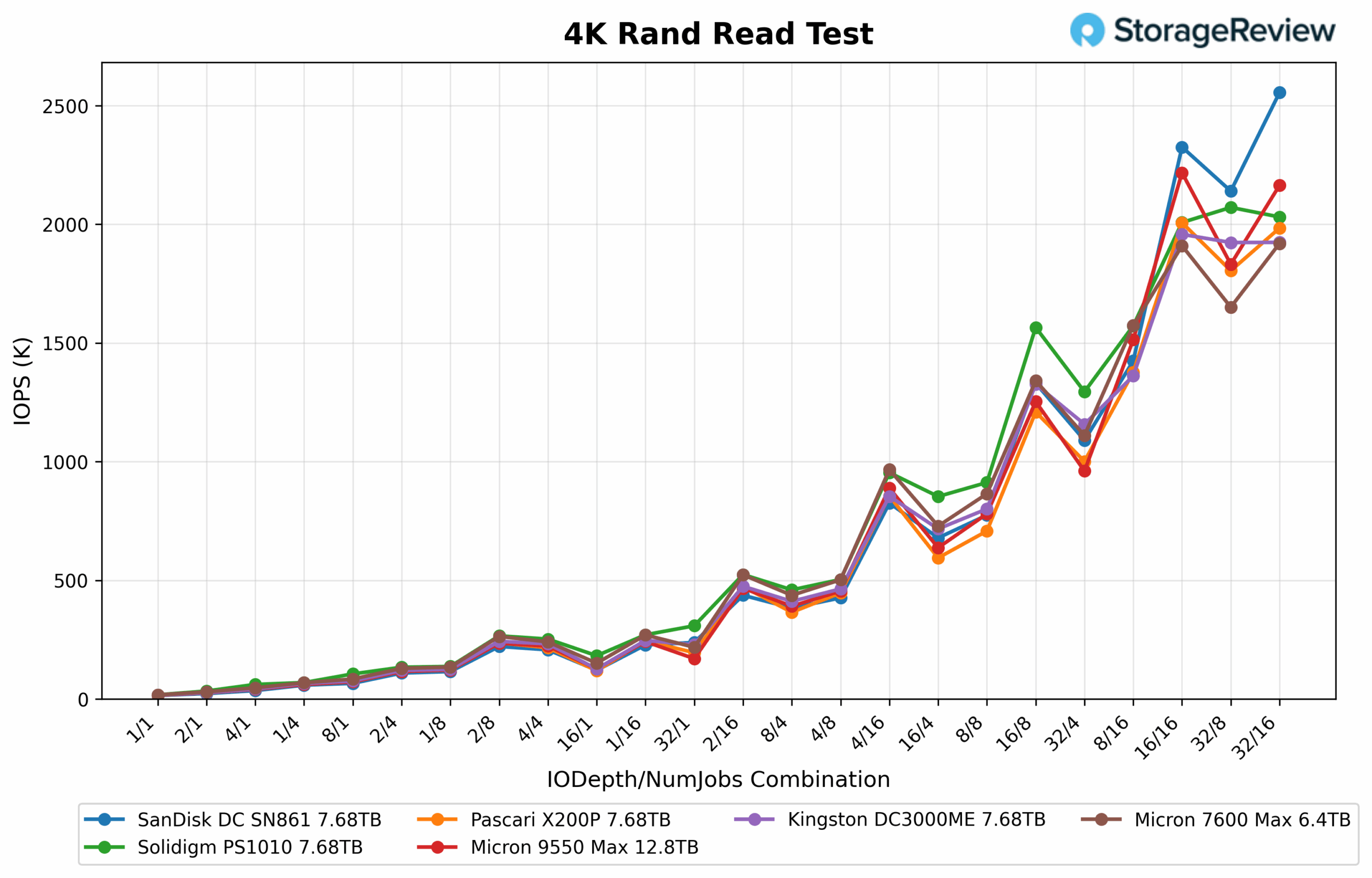
4K Random Read Latency
In the 4K random write latency results, the Micron 9550 Max (12.8TB) maintained some of the lowest response times under load, averaging around 0.03-0.05ms in the early part of the sweep and climbing gradually to the 0.35-0.38ms range at peak pressure. The Micron 7600 Max (6.4TB) followed closely, with slightly higher variance but still competitive, topping out just below 0.30ms at its maximum throughput.
By comparison, the SanDisk DC SN861 and Pascari X200P showed sharper spikes in latency as throughput scaled, with SanDisk surging above 0.40ms and Pascari extending to over 0.50ms at the highest queue depths. The Kingston DC3000ME trailed behind these two, peaking at just above 0.50ms but staying relatively consistent at lower workloads. The Solidigm PS1010 lagged the most, with early climbs already in the 0.10ms+ range and peaking at 0.73ms, reflecting instability under heavier random-write pressure.
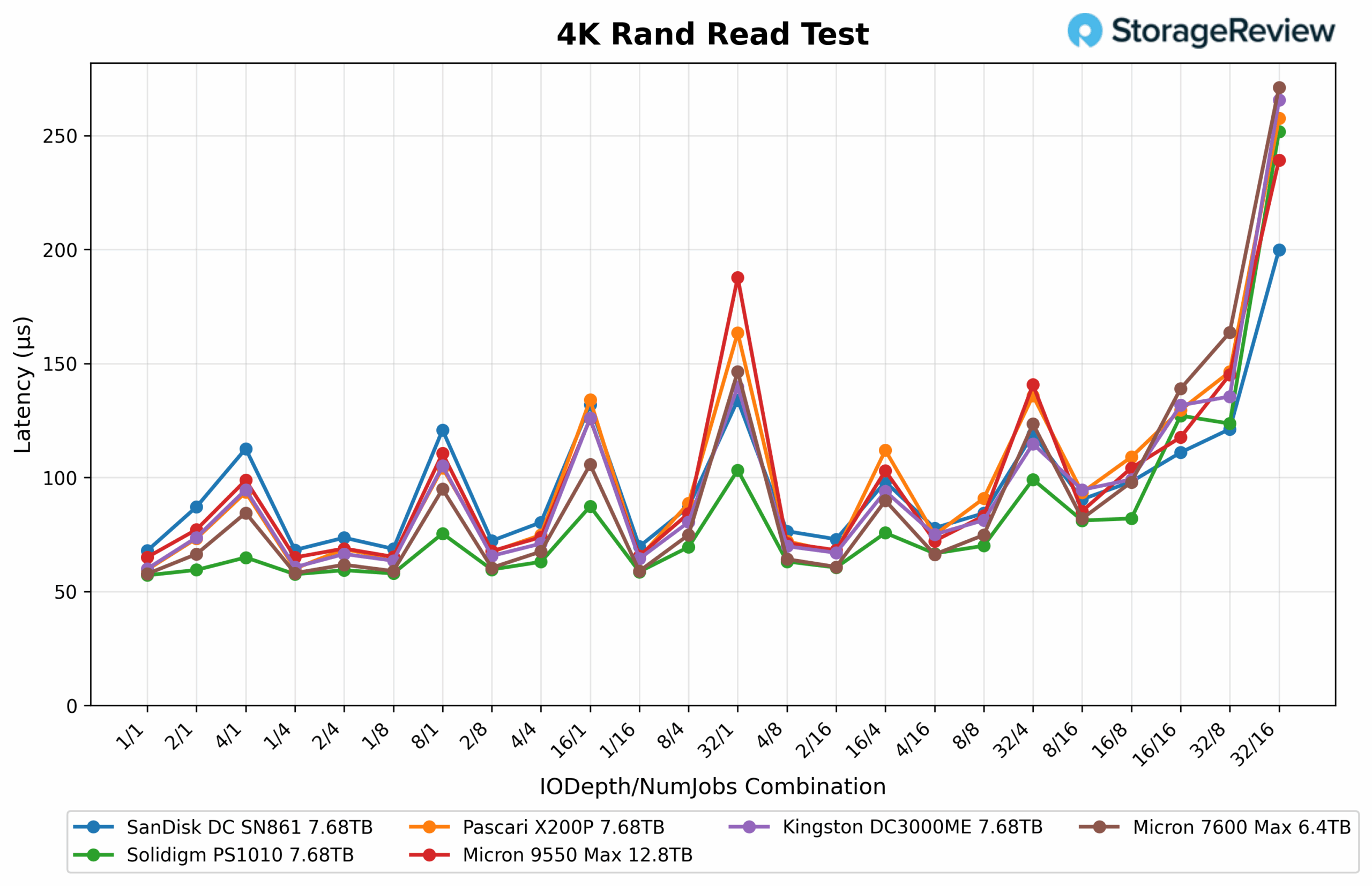
GPU Direct Storage
One of the tests we conducted on this testbench was the Magnum IO GPU Direct Storage (GDS) test. GDS is a feature developed by NVIDIA that allows GPUs to bypass the CPU when accessing data stored on NVMe drives or other high-speed storage devices. Instead of routing data through the CPU and system memory, GDS enables direct communication between the GPU and the storage device, significantly reducing latency and improving data throughput.
How GPU Direct Storage Works
Traditionally, when a GPU processes data stored on an NVMe drive, the data must first travel through the CPU and system memory before reaching the GPU. This process introduces bottlenecks, as the CPU acts as an intermediary, adding latency and consuming valuable system resources. GPU Direct Storage eliminates this inefficiency by enabling the GPU to access data directly from the storage device via the PCIe bus. This direct path reduces data-movement overhead, enabling faster, more efficient data transfers.
AI workloads, especially those involving deep learning, are highly data-intensive. Training large neural networks requires processing terabytes of data, and any delay in data transfer can lead to underutilized GPUs and longer training times. GPU Direct Storage addresses this challenge by ensuring that data is delivered to the GPU as quickly as possible, minimizing idle time and maximizing computational efficiency.
In addition, GDS is particularly beneficial for workloads that involve streaming large datasets, such as video processing, natural language processing, or real-time inference. By reducing the reliance on the CPU, GDS accelerates data movement and frees up CPU resources for other tasks, further enhancing overall system performance.
GDSIO Sequential Read Throughout
In our GDSIO sequential read tests, starting with small block transfers at 16K, the Micron 9550 Max throughput began around 0.5 GiB/s at low queue depths and gradually ramped to roughly 1.9 GiB/s at QD128. Moving to 128K block sizes increased performance substantially, reaching 1.4 GiB/s at QD1 and peaking around 5.3 GiB/s at QD64–128. In the 1M block tests, the drive showed its strongest results, scaling from 2.0 GiB/s at shallow queues to 6.1 GiB/s at QD128, showing consistent growth and solid efficiency across all depths.
Compared with the Micron 7600 Max, the 9550 Max followed a similar trajectory, with slightly higher peak throughput. The 7600 Max began its 16K tests around 0.5 GiB/s and topped out near 1.9 GiB/s, almost identical to the 9550 Max at small block workloads. At 128K, it started stronger at 2.2 GiB/s but peaked at about 5.0 GiB/s, while its 1M block results reached around 5.6 GiB/s. The overall takeaway is that both drives delivered predictable scaling and strong sequential performance, with the 9550 Max holding a slight but consistent advantage at higher queue depths and larger block sizes.
Looking across the other enterprise drives tested, including the Pascari X200P, Kingston DC3000ME, Solidigm PS1010, and SanDisk DC SN861, throughput results generally ranged between 5.0 GiB/s and 6.1 GiB/s at the upper end. The range across all models remained relatively narrow, showing how efficiently current enterprise SSDs handle GPU-direct workloads. In this group, the Micron drives consistently ranked among the top performers, with the 9550 Max maintaining a slight edge at higher queue depths. In contrast, the others followed closely behind within a few tenths of a GiB/s, depending on workload intensity.
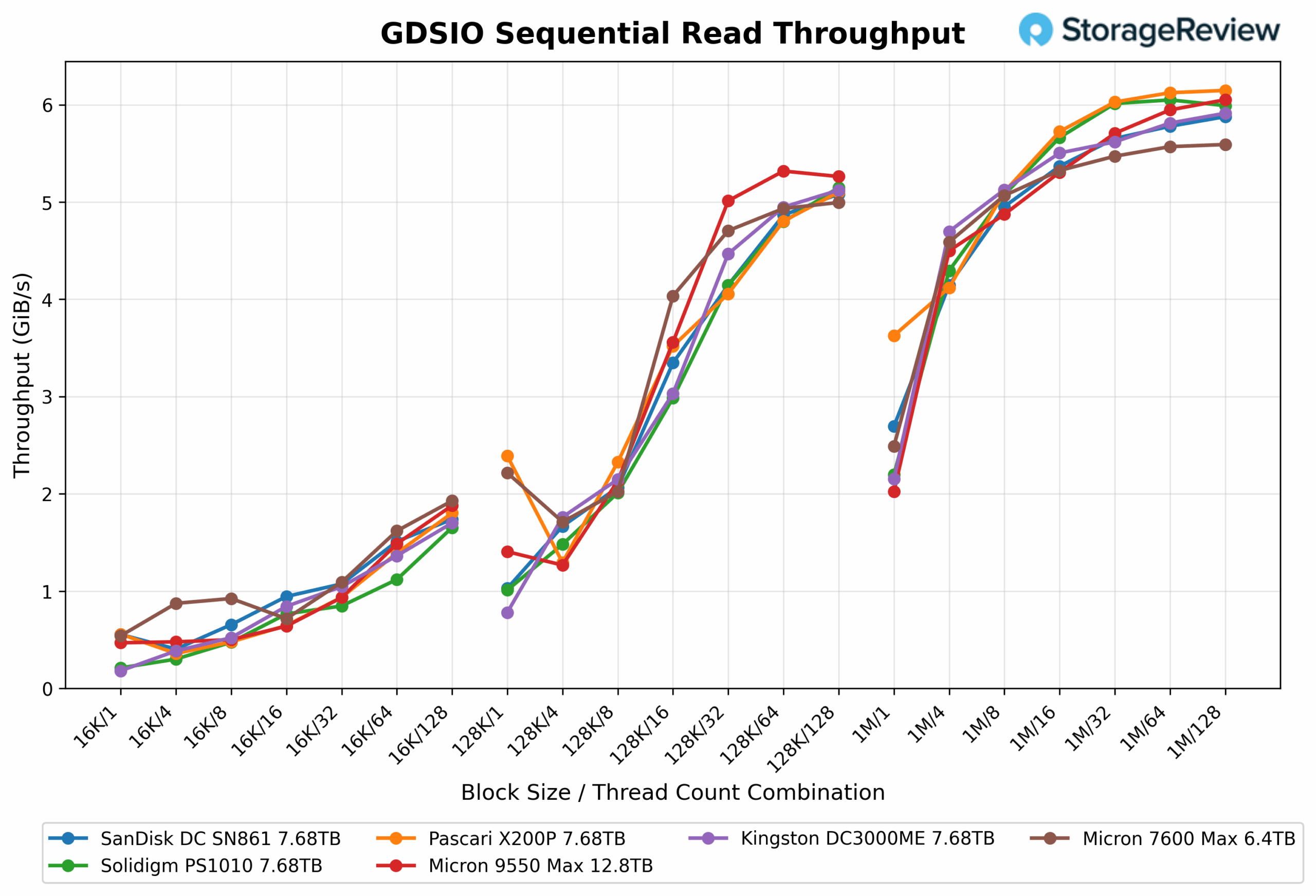
GDSIO Sequential Read Latency
In sequential read latency testing, both Micron drives demonstrated tight and consistent response times across all block sizes and queue depths. The Micron 9550 Max began with very low latency at smaller block sizes, measuring around 31µs at QD1 for 16K transfers and gradually increasing to about 1.0ms at QD128. At 128K block sizes, it ranged from 86µs to 3.0ms, while the 1M workloads rose from 482µs at shallow queues to 20.6ms at QD128.
The Micron 7600 Max demonstrated a similar pattern, beginning slightly faster at the smallest blocks with 27µs at QD1 and ending at roughly 1.0ms by QD128. At 128K blocks, latency ranged from 54µs to 3.1ms, and at 1M blocks, it ranged from 391µs at QD1 to 22.3ms at QD128.
When viewed across the entire test group, all drives maintained near-parity through small and mid-range block sizes before naturally climbing at 1M workloads as queue depth increased. The Micron 9550 Max and 7600 Max remained tightly grouped throughout, reflecting stable latency scaling and minimal variation compared to peers like the Pascari X200P, Kingston DC3000ME, and Solidigm PS1010.
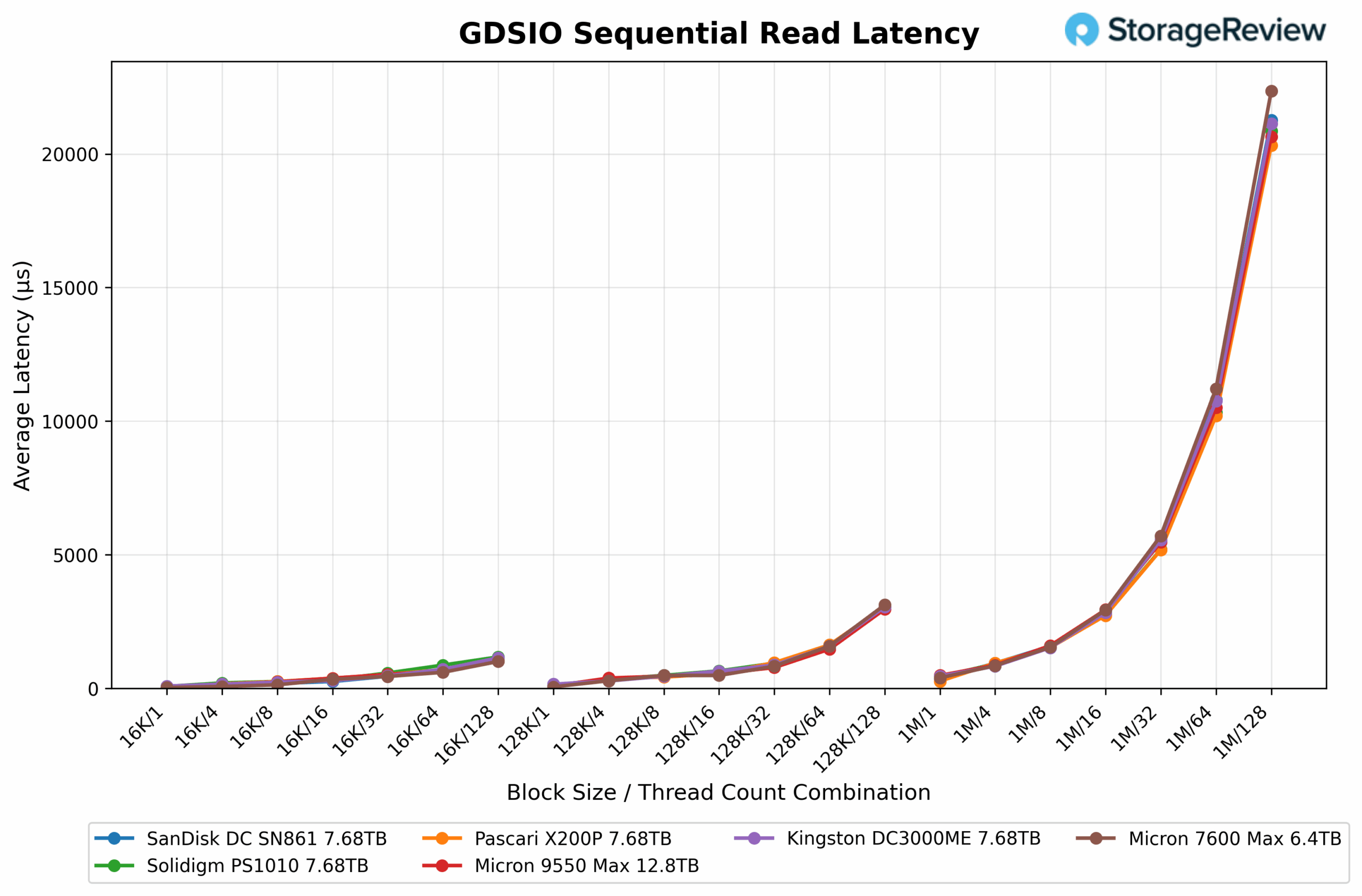
GDSIO Sequential Write Throughout
In GDSIO sequential write testing, the Micron 9550 Max delivered consistently strong throughput across all workloads. At smaller 16K block sizes, performance began around 0.5 GiB/s and climbed to roughly 1.5 GiB/s by QD32 before tapering slightly at the highest queue depth. At 128K blocks, throughput improved significantly, scaling from 2.3 GiB/s at QD1 to a peak of 5.3 GiB/s around QD32–64. The 1M block results remained in the same high-performance range, starting near 4.7 GiB/s and sustaining between 5.0 GiB/s and 5.4 GiB/s across moderate queue depths, then dropping slightly at QD128.
The Micron 7600 Max followed a nearly identical curve, beginning at 0.5 GiB/s at 16K and topping out at 1.5 GiB/s for smaller transfers. At 128K, it showed a steady climb from 2.2 GiB/s to 5.2 GiB/s, while the 1M block workloads maintained throughput between 4.1 GiB/s and 5.4 GiB/s through mid-range queue depths. Both drives showed excellent consistency, with minimal performance variation even as queue depths increased, which highlights the efficiency of Micron’s firmware tuning under GPU-direct workloads.
Looking at the broader dataset, overall throughput across all tested enterprise drives converged within a tight range of 4.0-5.4 GiB/s at peak load. Drives like the Pascari X200P and Micron 7600 Max hovered near the upper range, while others, such as the Kingston DC3000ME, Solidigm PS1010, and SanDisk DC SN861, followed closely behind.
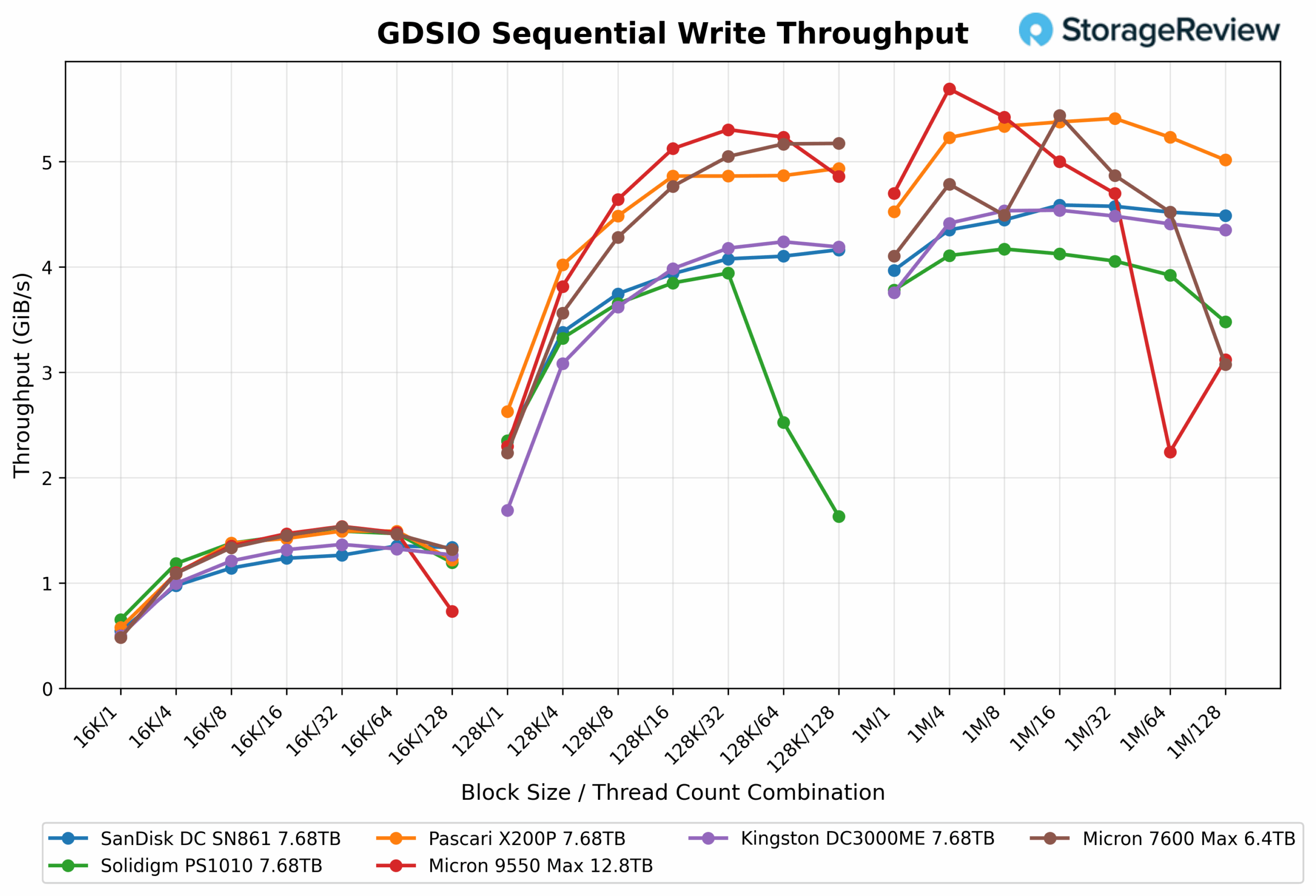
GDSIO Sequential Write Latency
In sequential write latency testing, both Micron drives demonstrated stable, predictable response times that scaled linearly with queue depth and block size. The Micron 9550 Max began with near-identical low-latency performance to the 7600 Max at smaller transfers, posting 30µs at QD1 for 16K blocks and scaling to 2.7ms at QD128. At 128K blocks, latency increased gradually from 52µs to 3.2ms, while 1M block workloads showed 207µs at QD1 and reached around 40ms by the deepest queue depth.
The Micron 7600 Max followed the same behavior with only minor variation. It recorded 30µs at QD1 for 16K blocks and topped out at 1.5ms at QD128. At 128K, latency ranged between 54µs and 3.0ms, and for 1M transfers, it climbed from 237µs at QD1 to 40.7ms at QD128.
Across the group comparison, all drives showed consistent behavior with increasing queue depth, maintaining similar scaling patterns. The Micron drives aligned closely with the Pascari X200P and Kingston DC3000ME throughout most of the range, and both exhibited excellent low-latency characteristics at smaller block sizes while sustaining predictable increases under heavier sequential write conditions.
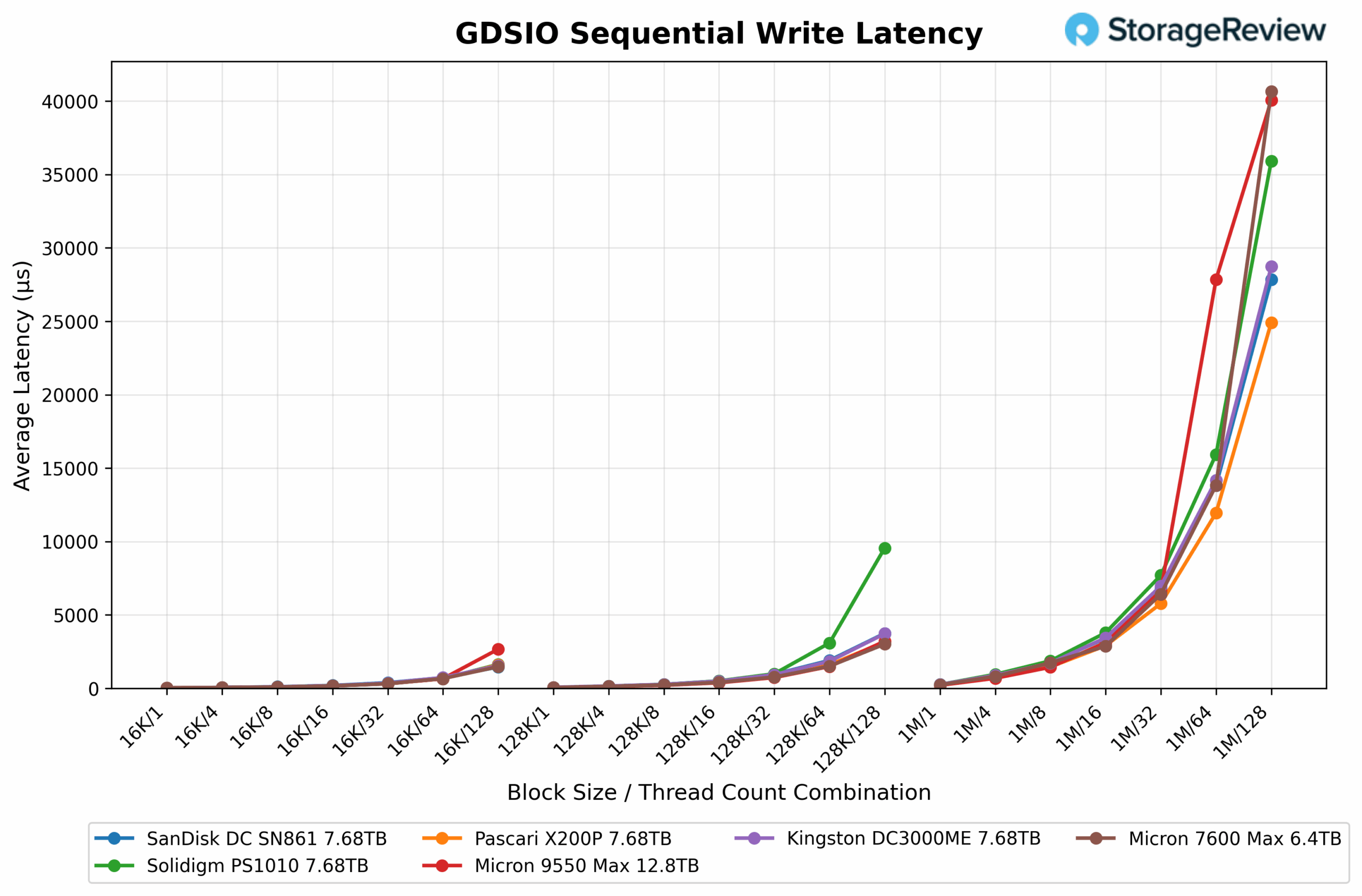
Conclusion
The Micron 9550 Max continues Micron’s strong trajectory in the enterprise SSD space, delivering a refined balance of endurance, throughput, and efficiency for current data-intensive workloads. Designed for mixed-use environments, it demonstrated the ability to sustain high performance under both sequential and random operations, with latency stability and write endurance up to 3 DWPD.
Throughout our testing, the 9550 Max proved that it can handle enterprise and AI/ML pipelines with ease, offering predictable scaling in GPU-direct storage, FIO, and DLIO environments alike. Its performance profile stays consistent across varying workloads and queue depths, reflecting the maturity of Micron’s Gen5 platform and firmware optimization. Compared to the 7600 Max, the 9550 Max offers a small but measurable improvement in throughput and responsiveness, particularly at higher depths, while maintaining the same low-latency characteristics that make both models strong contenders in their respective tiers.
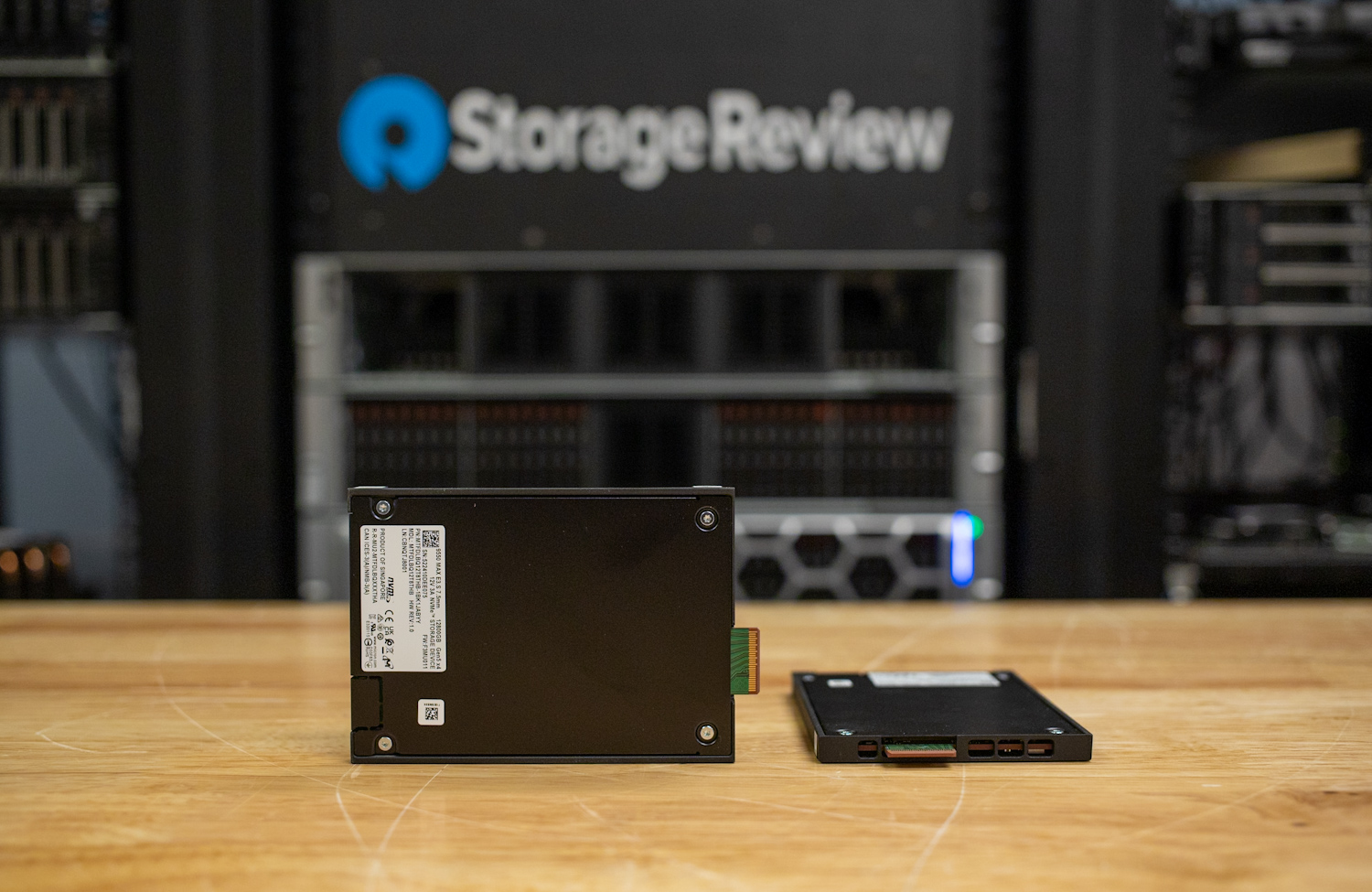
From a deployment perspective, the flexibility of U.2 and E3.S form factors ensures smooth adoption across both legacy and next-generation infrastructures. Power efficiency and OCP compliance further enhance its fit for dense data center deployments.
Overall, the Micron 9550 Max stands out as a well-rounded enterprise SSD that blends sustained mixed-workload performance with operational efficiency and reliability. It’s a clear step forward for organizations seeking PCIe Gen5 readiness without sacrificing stability or longevity, making it one of the most capable mixed-use NVMe solutions currently available.




 Amazon
Amazon